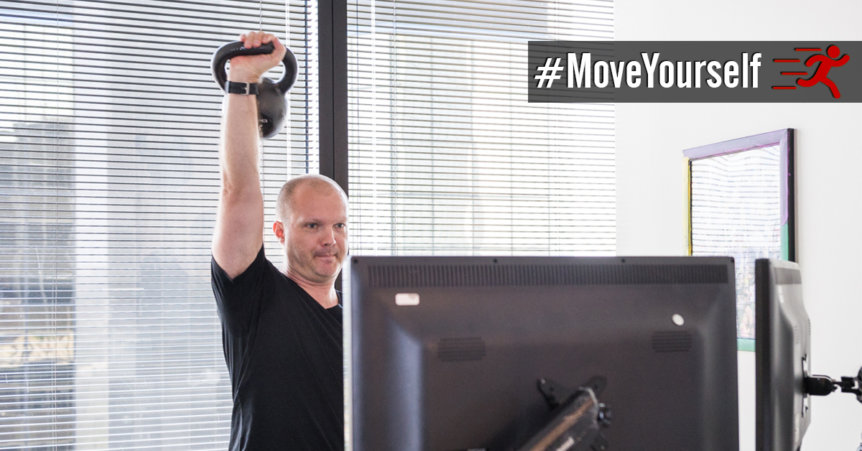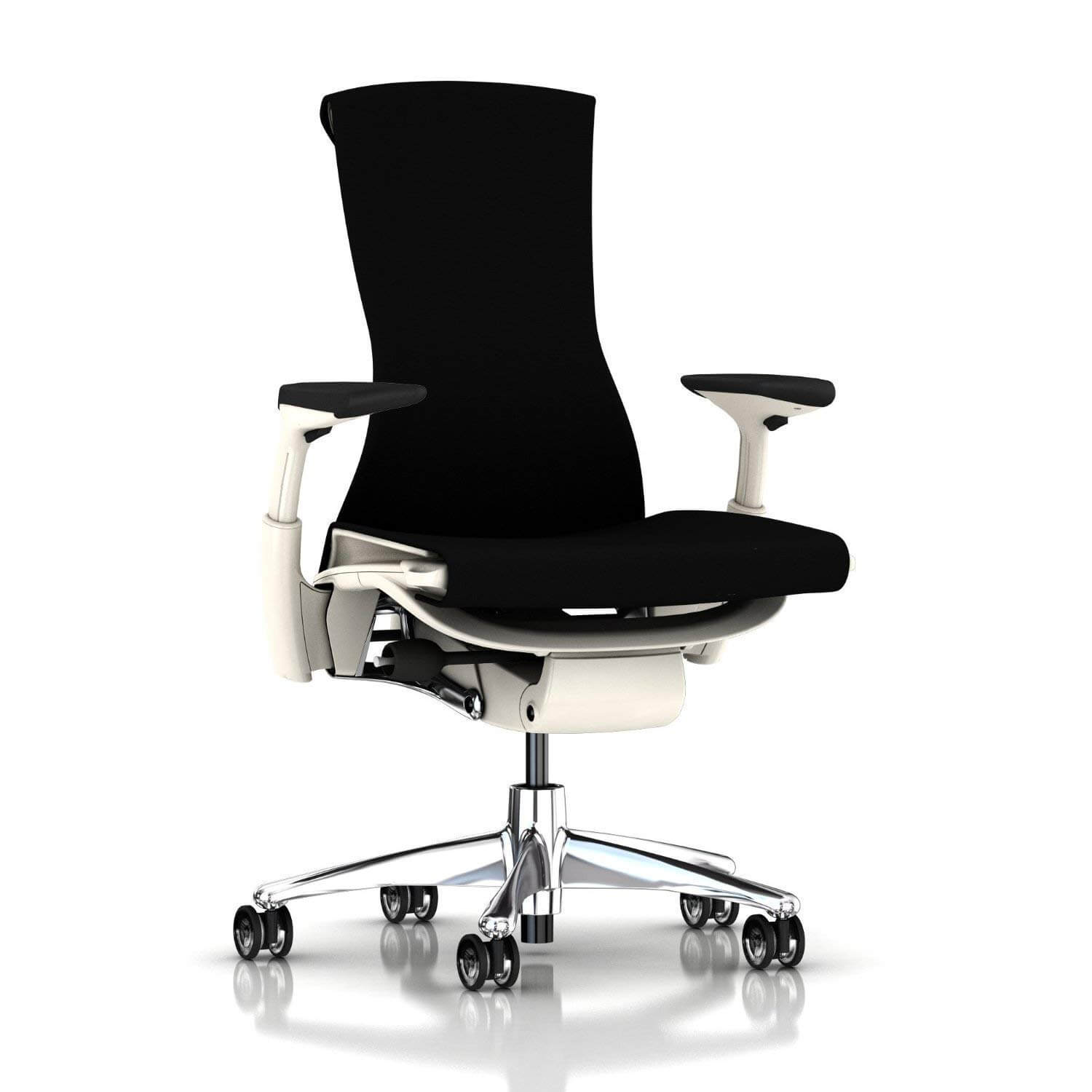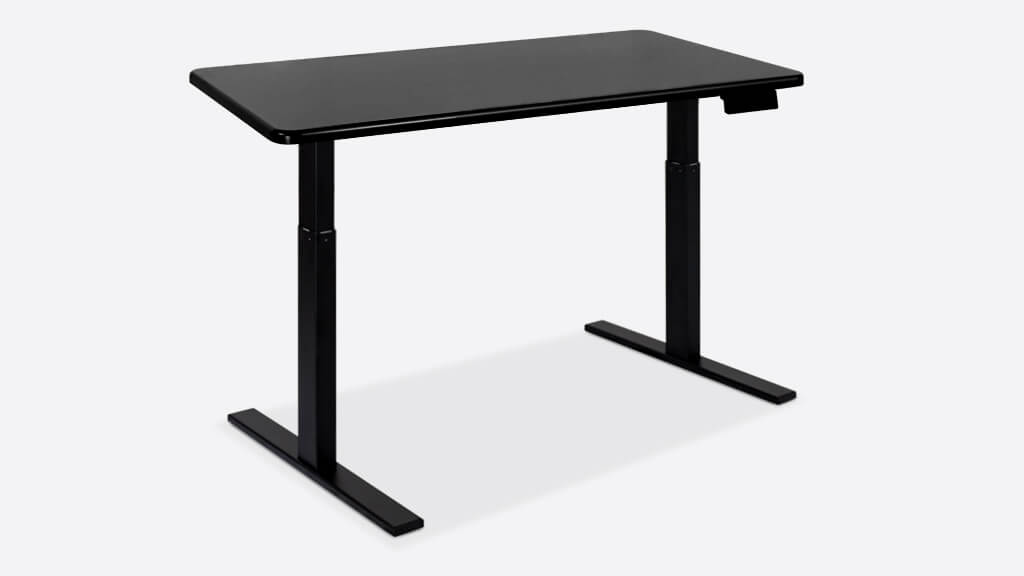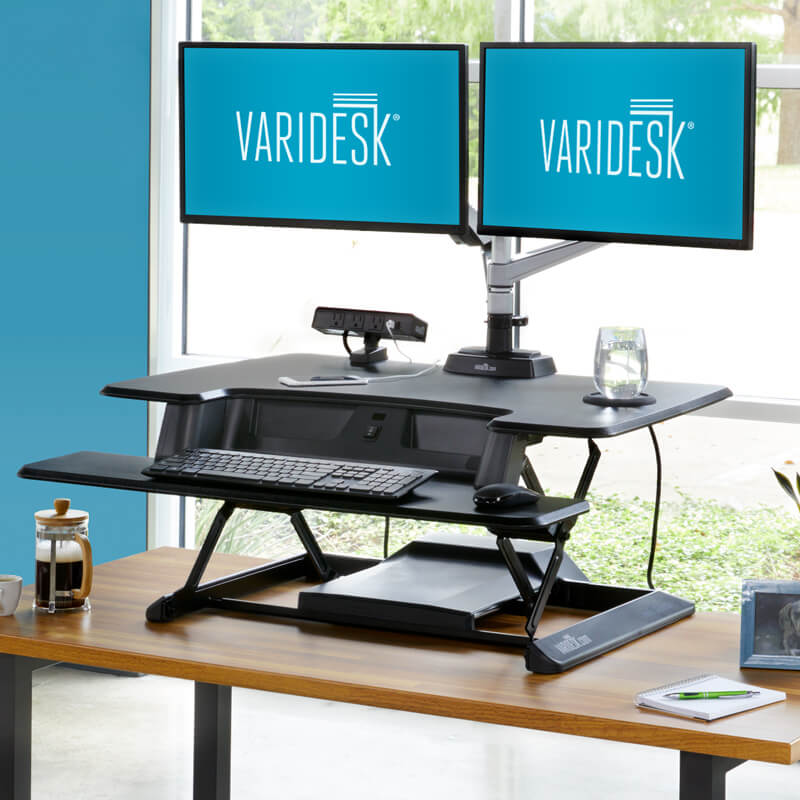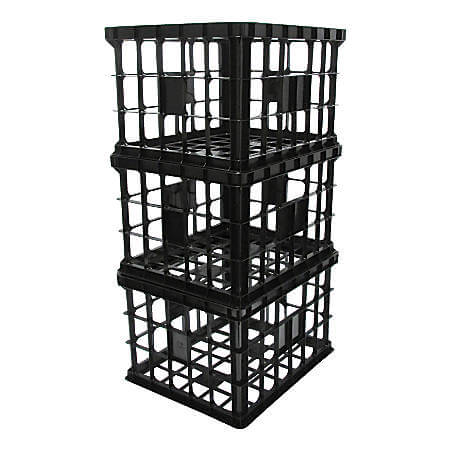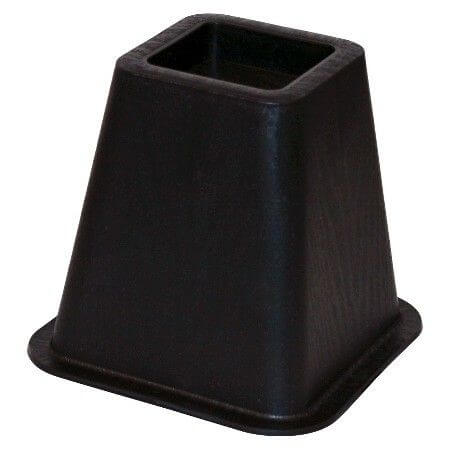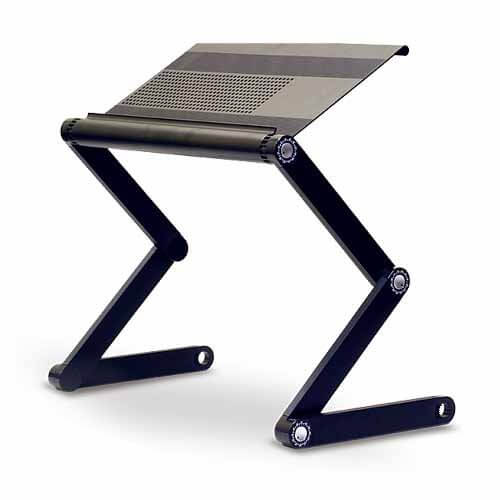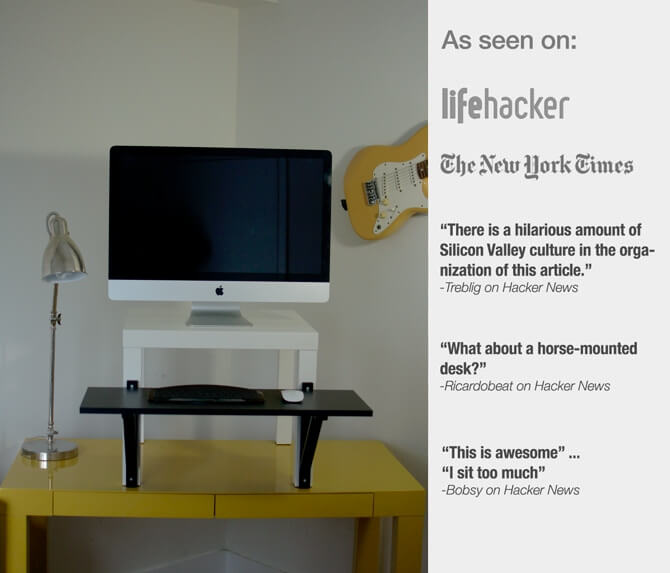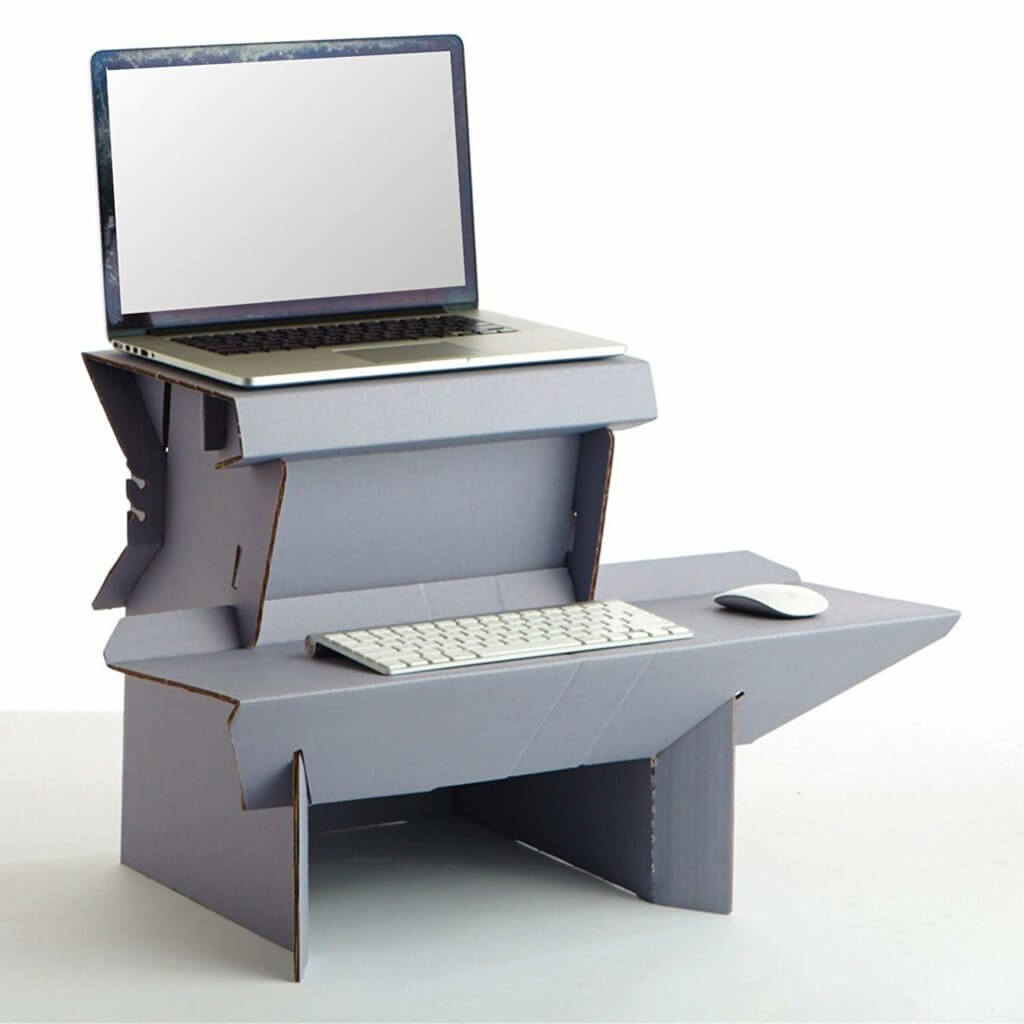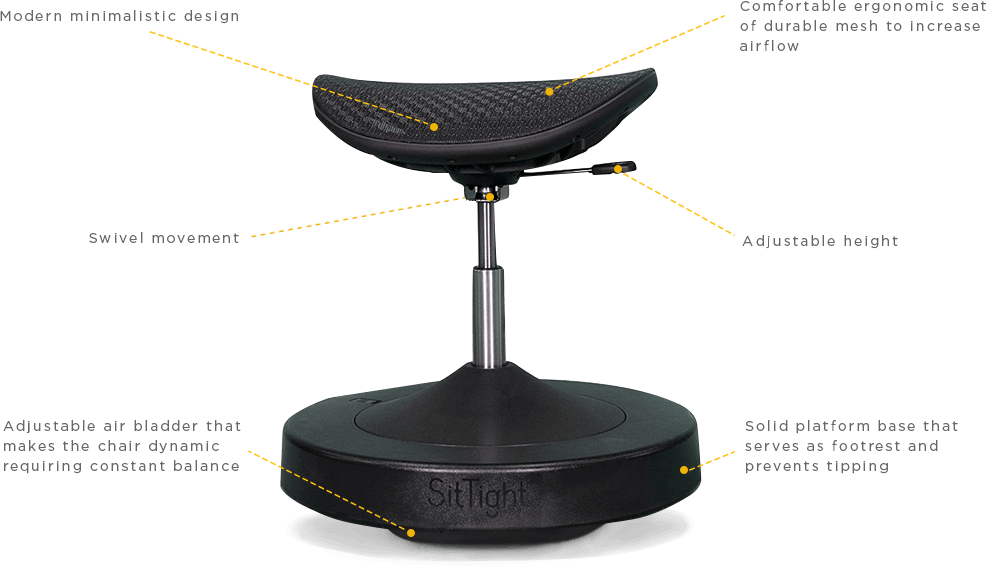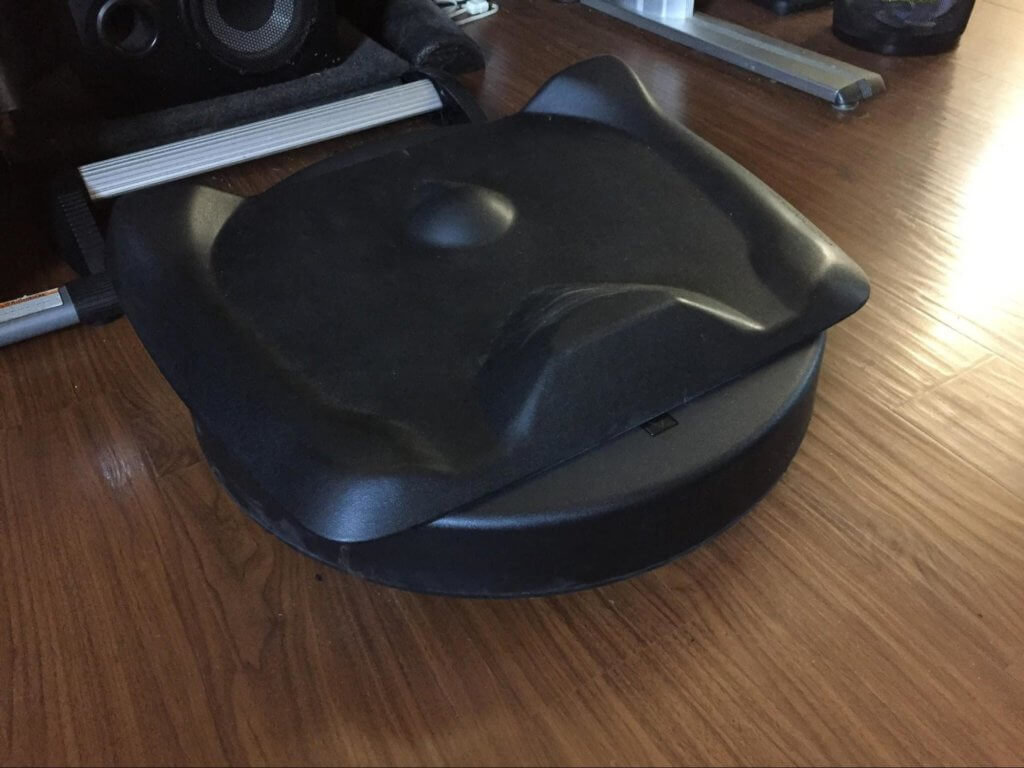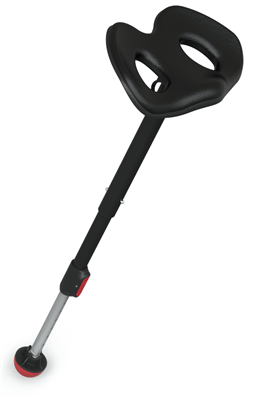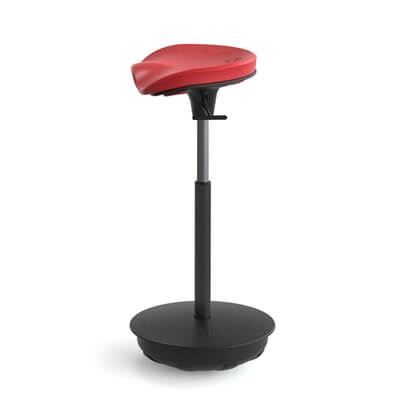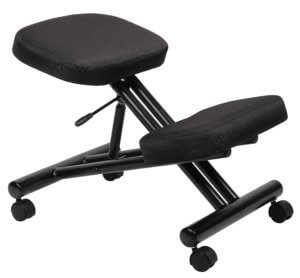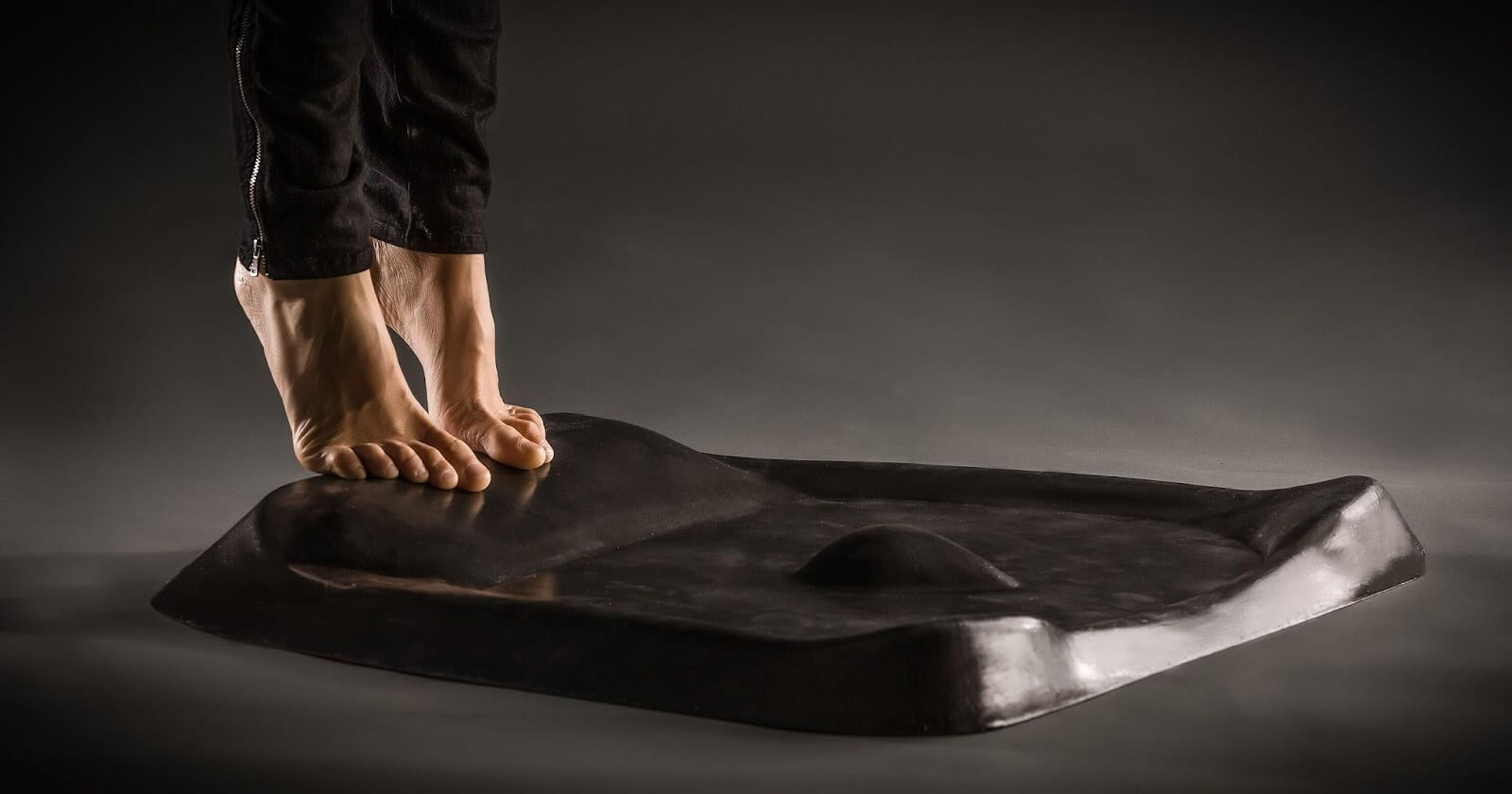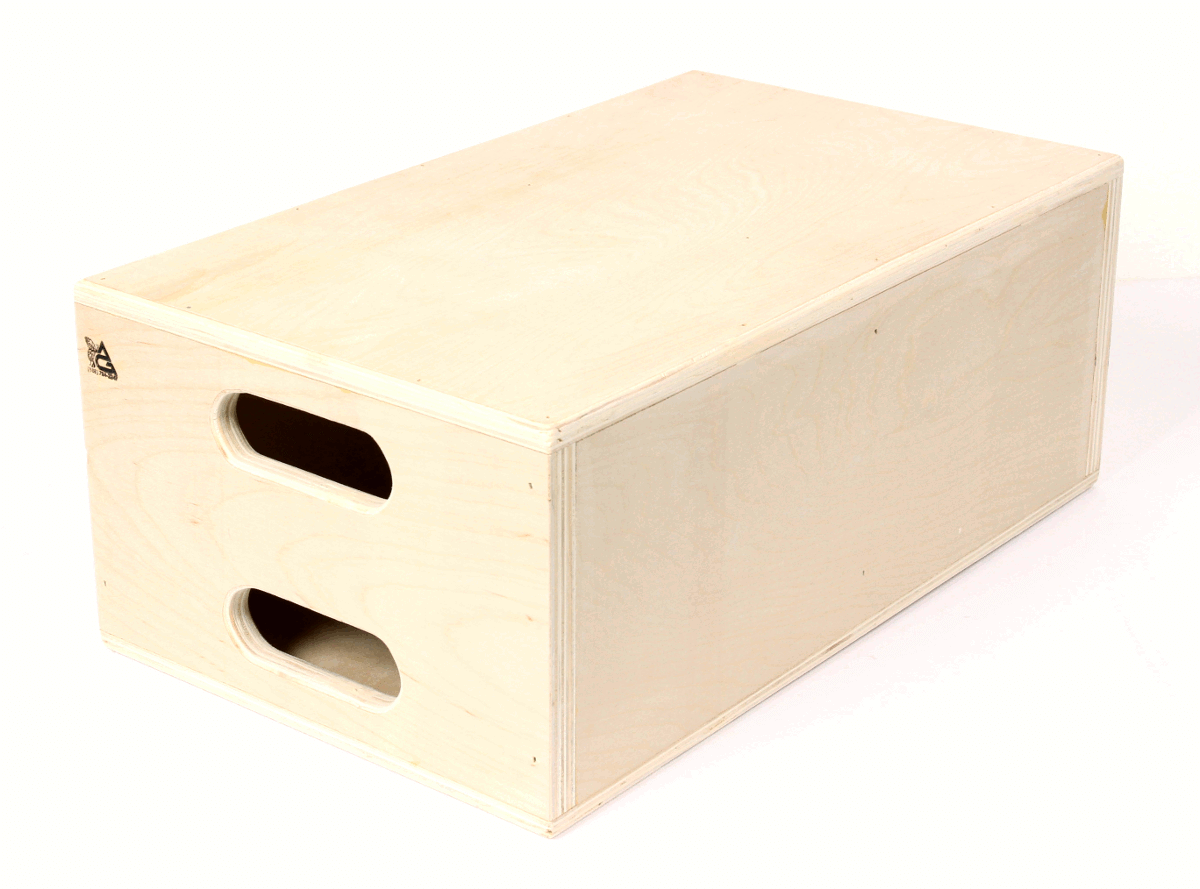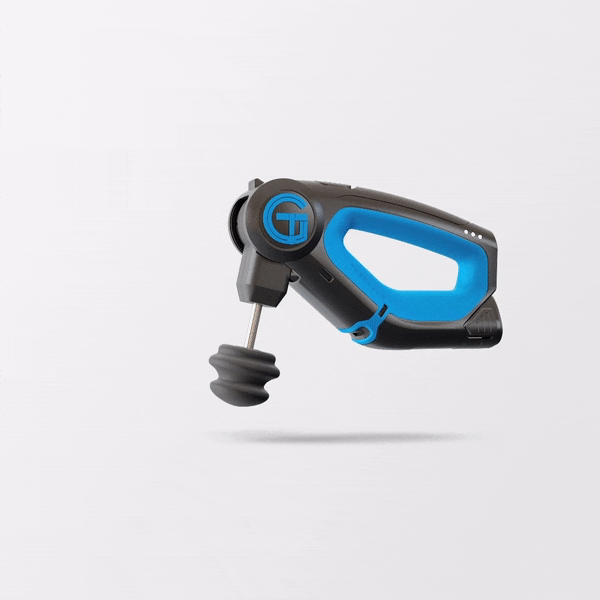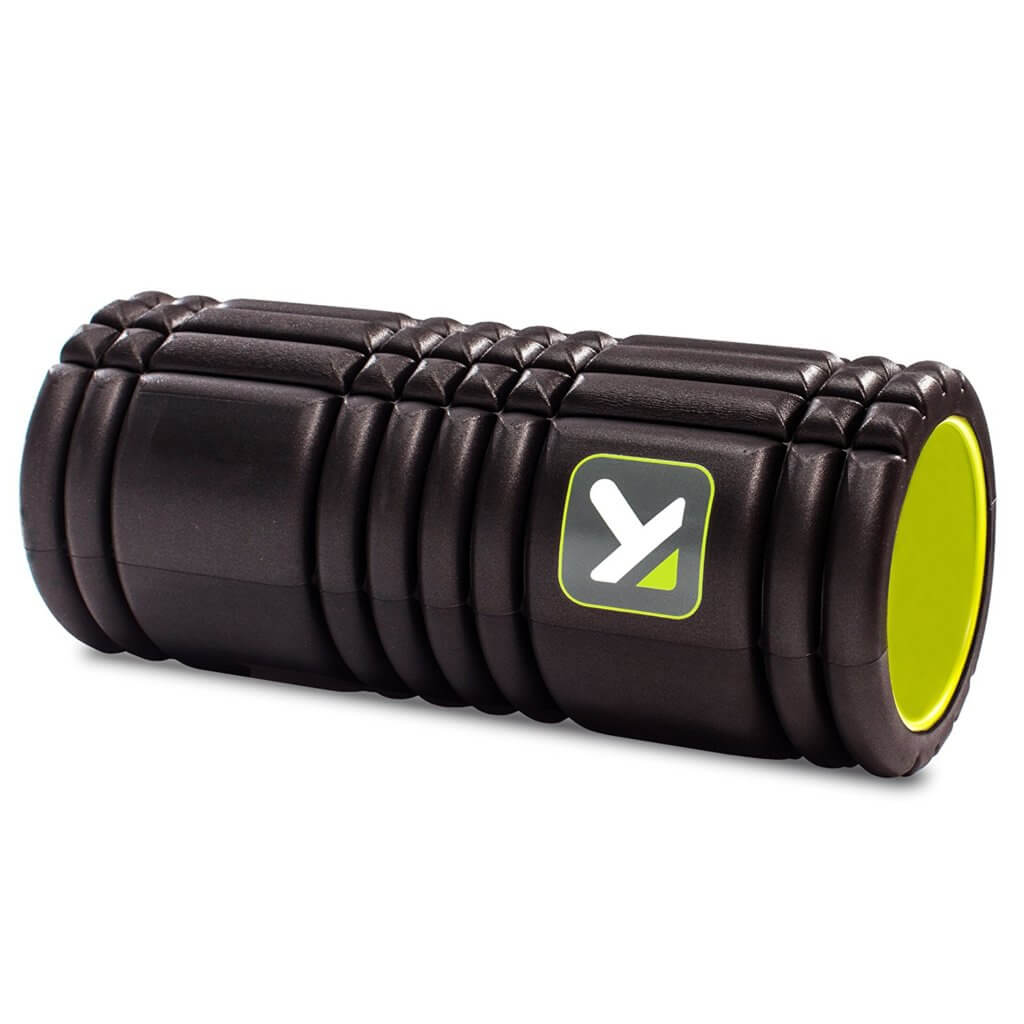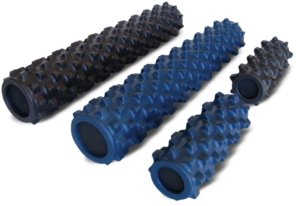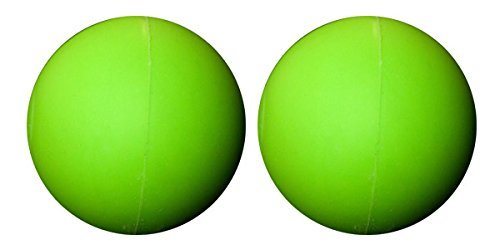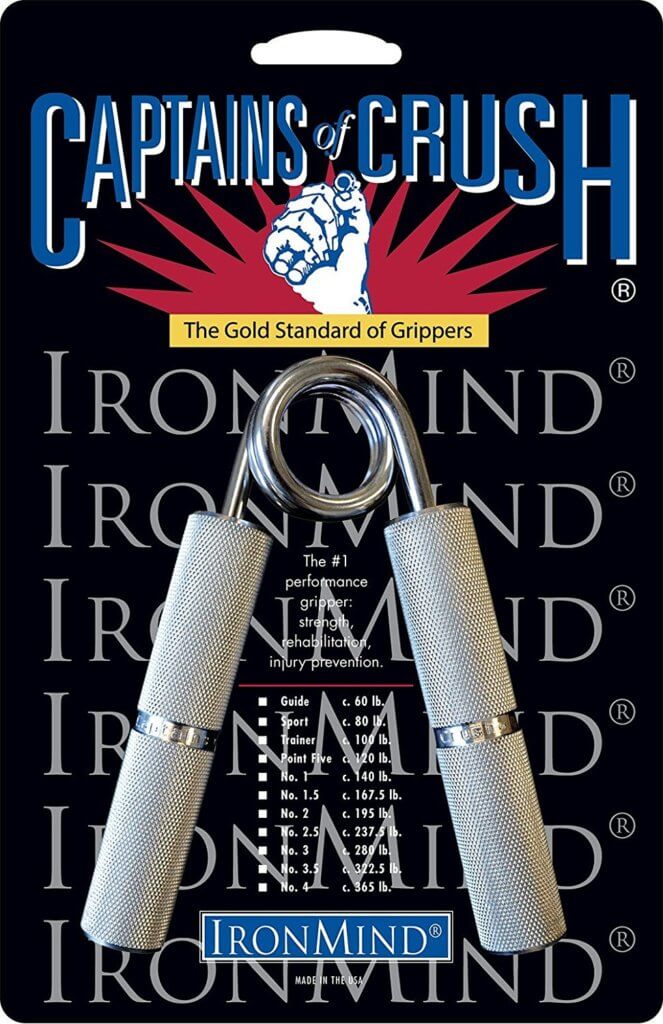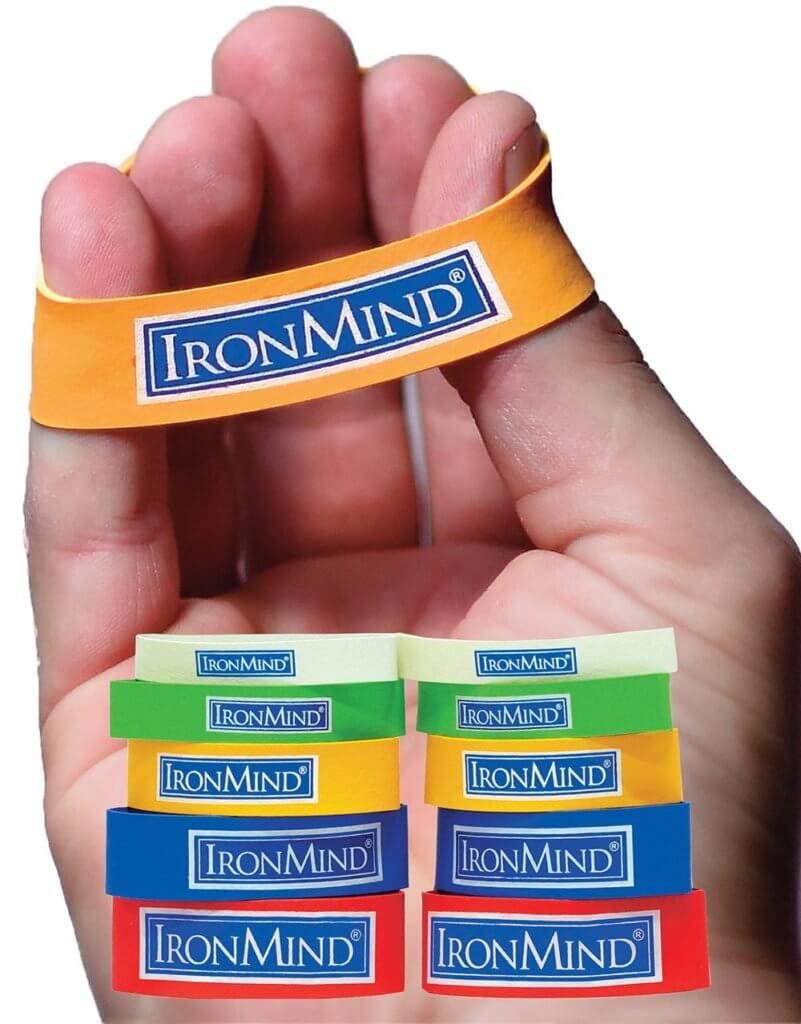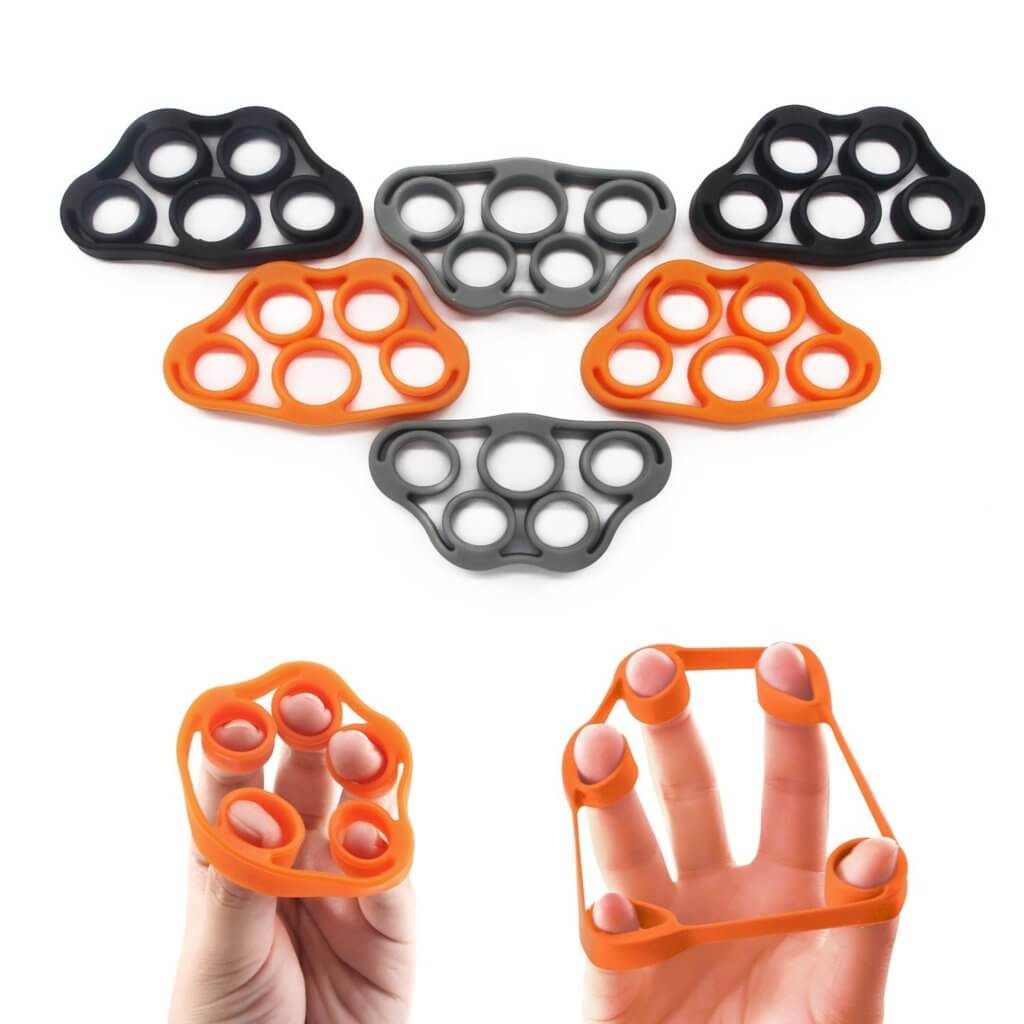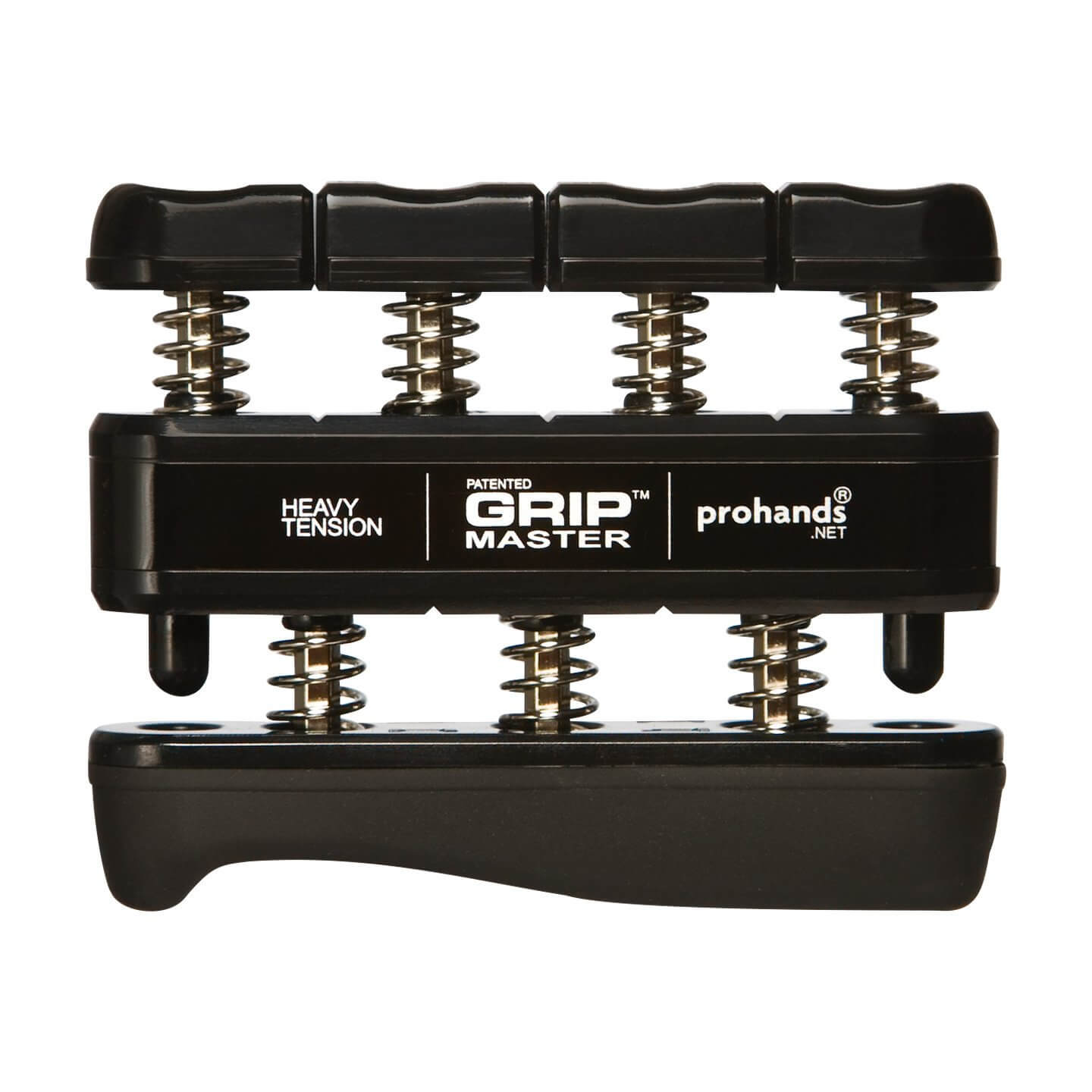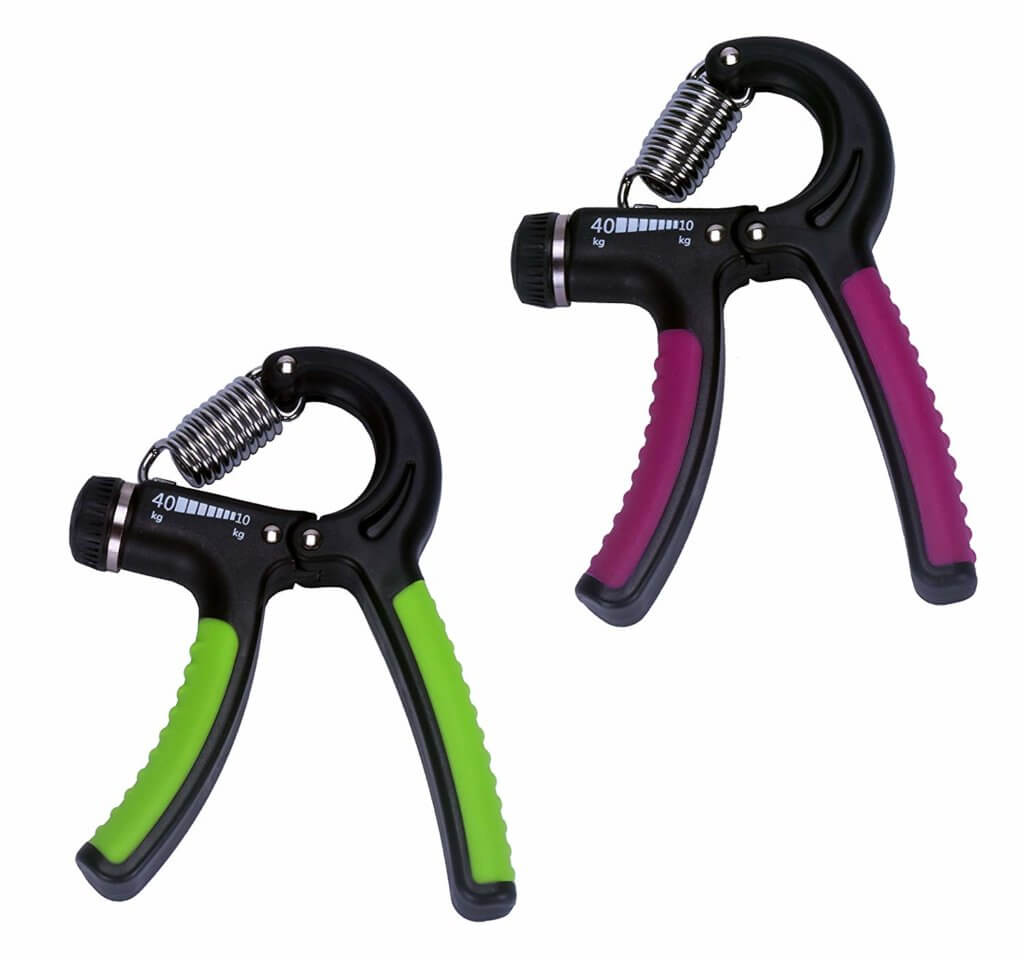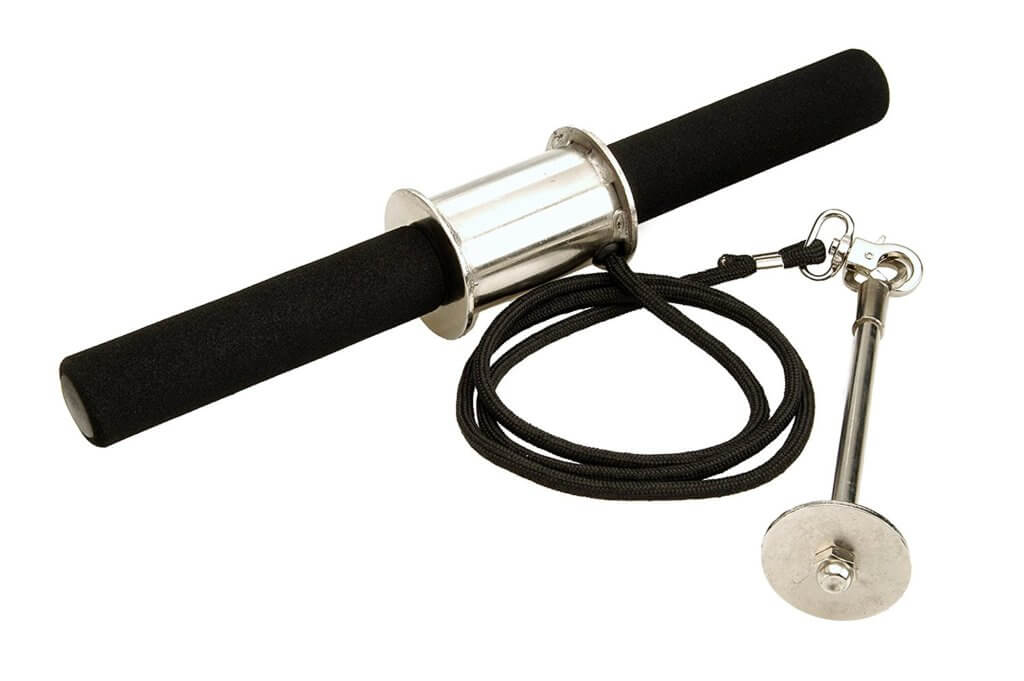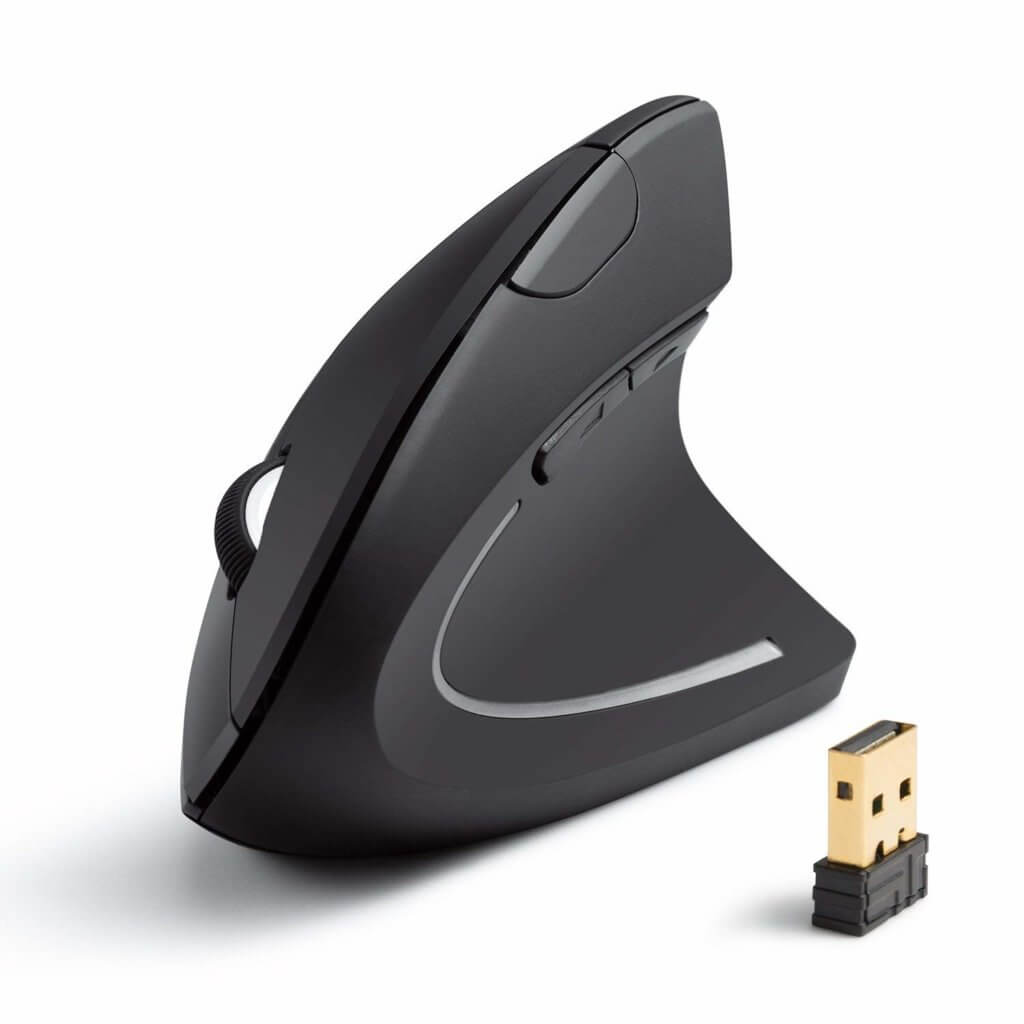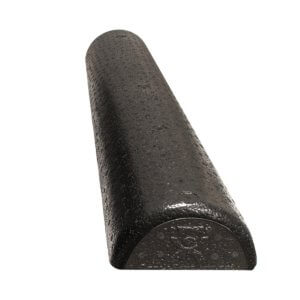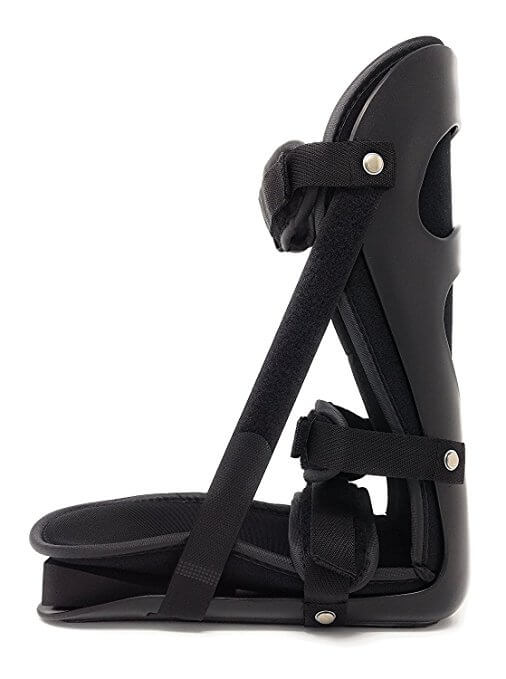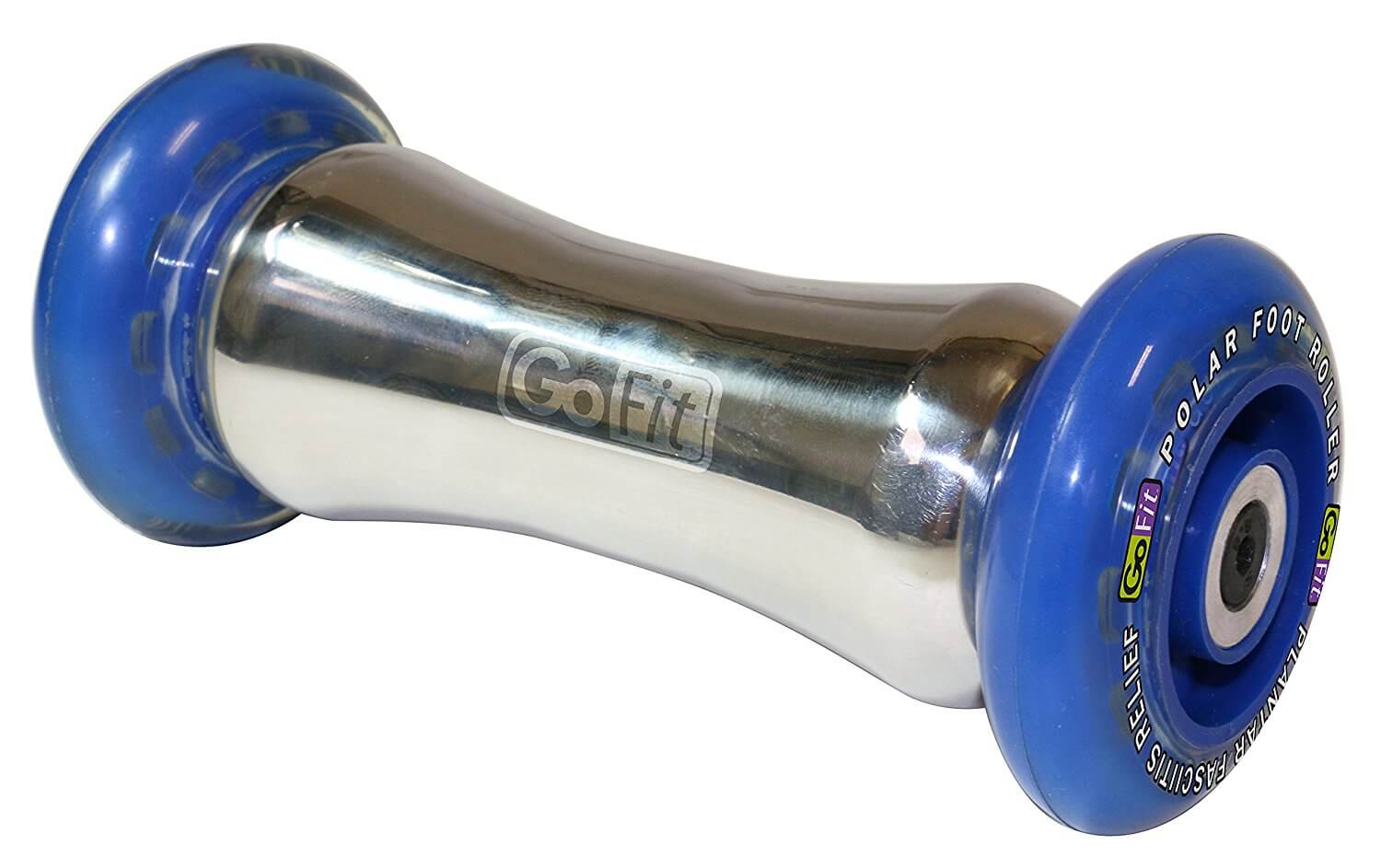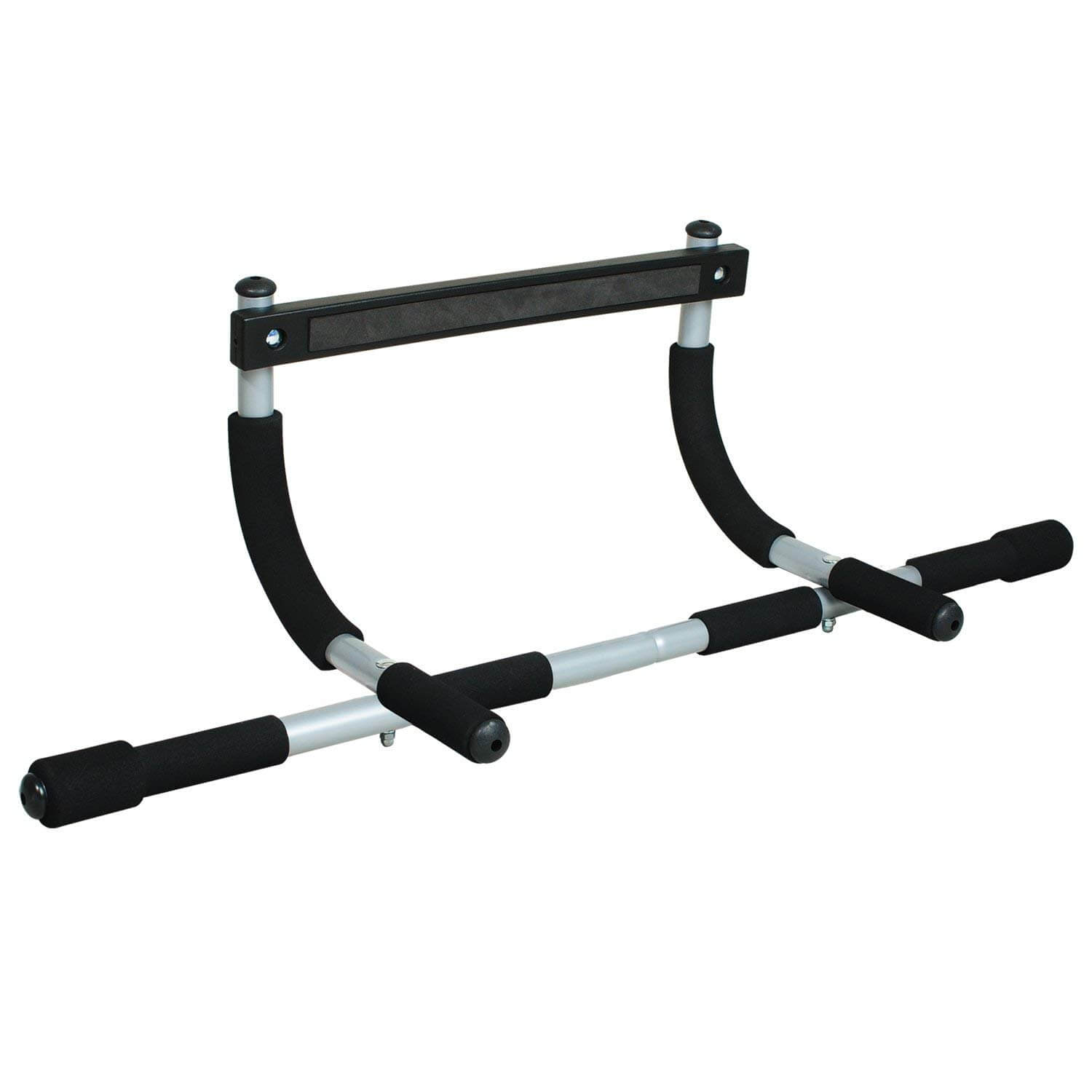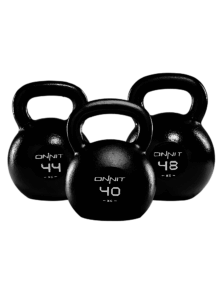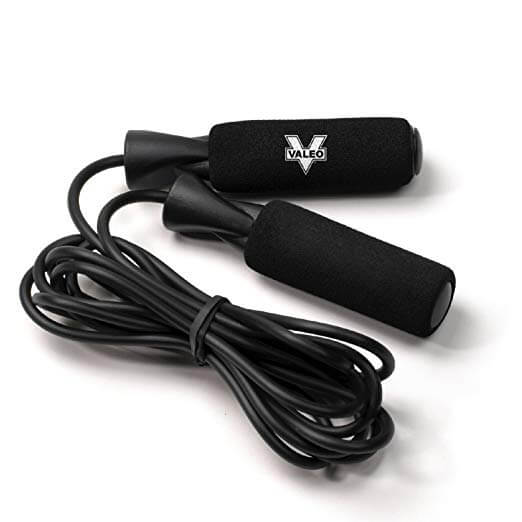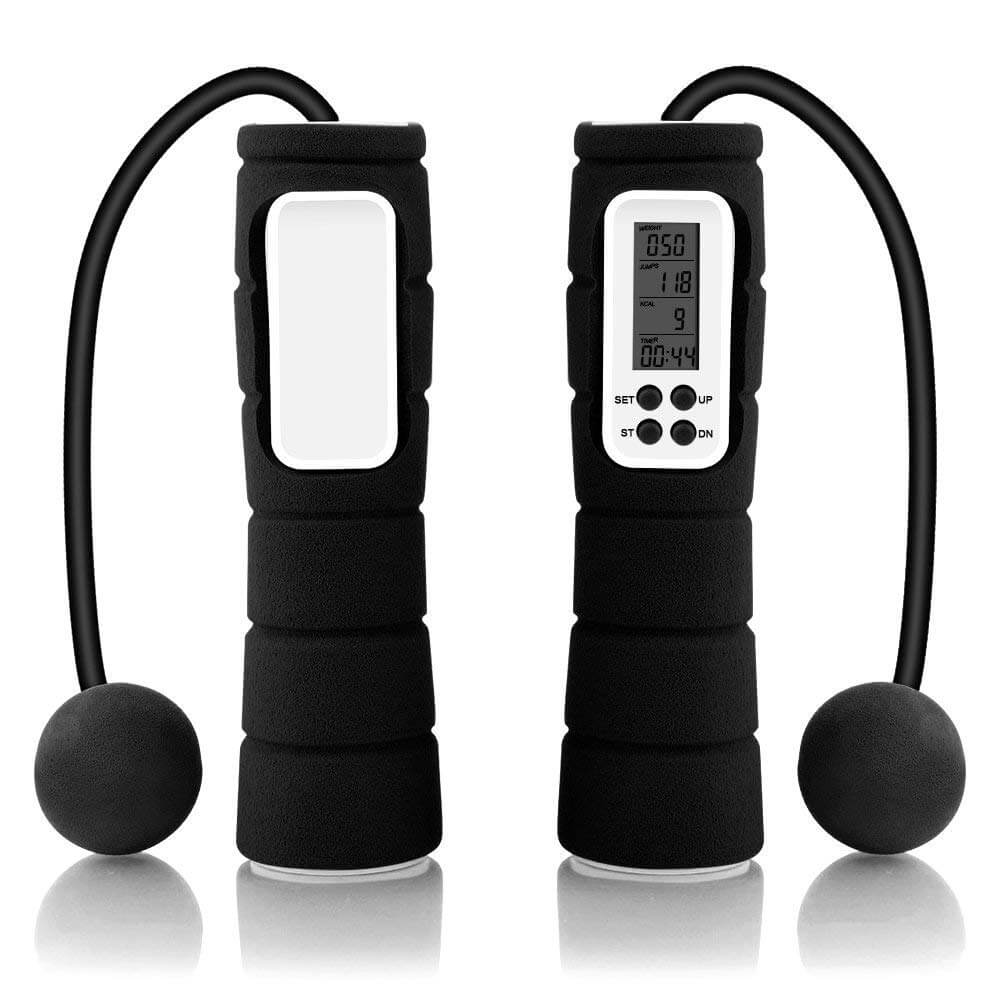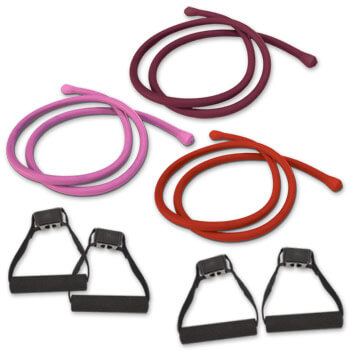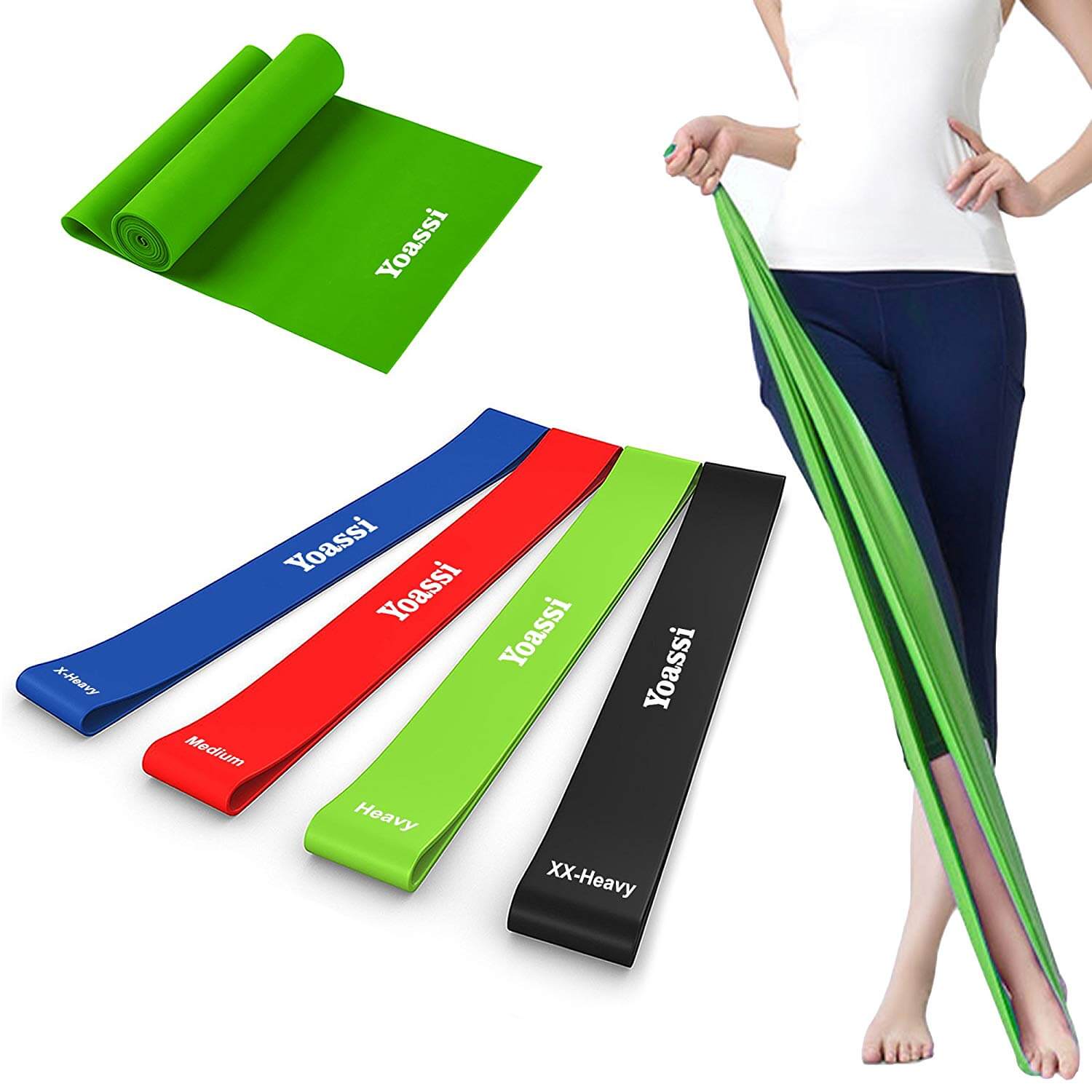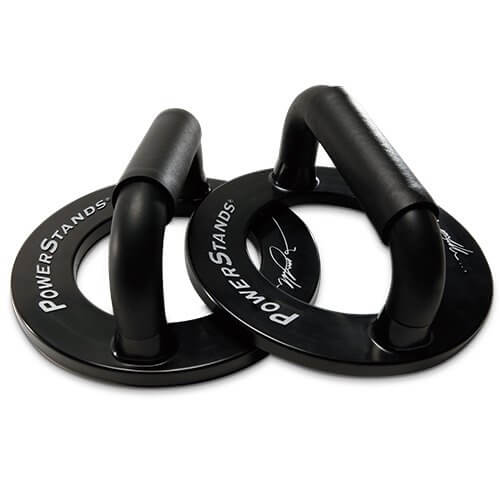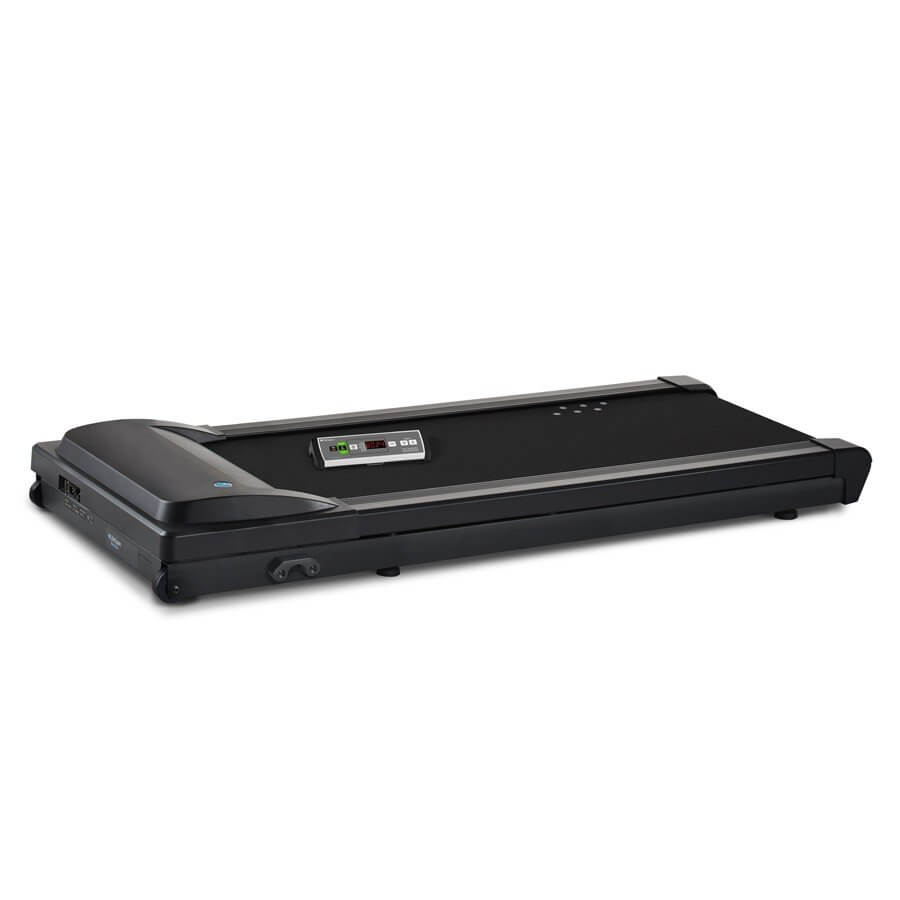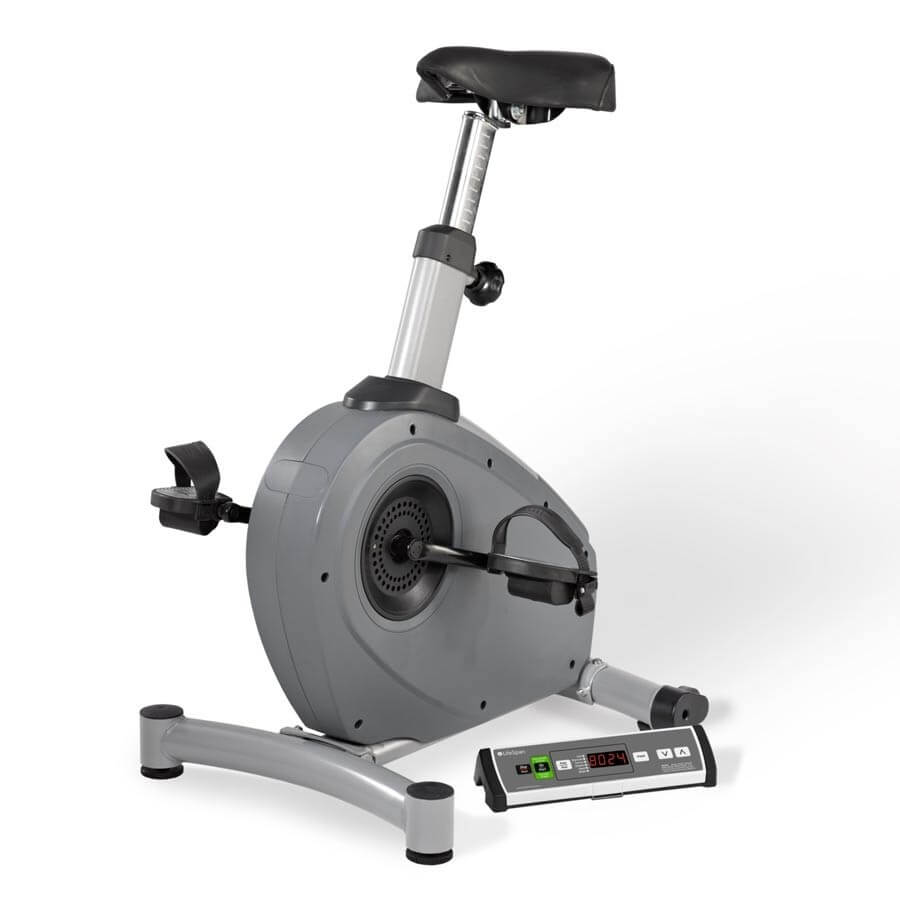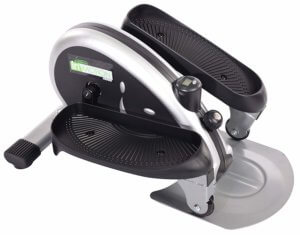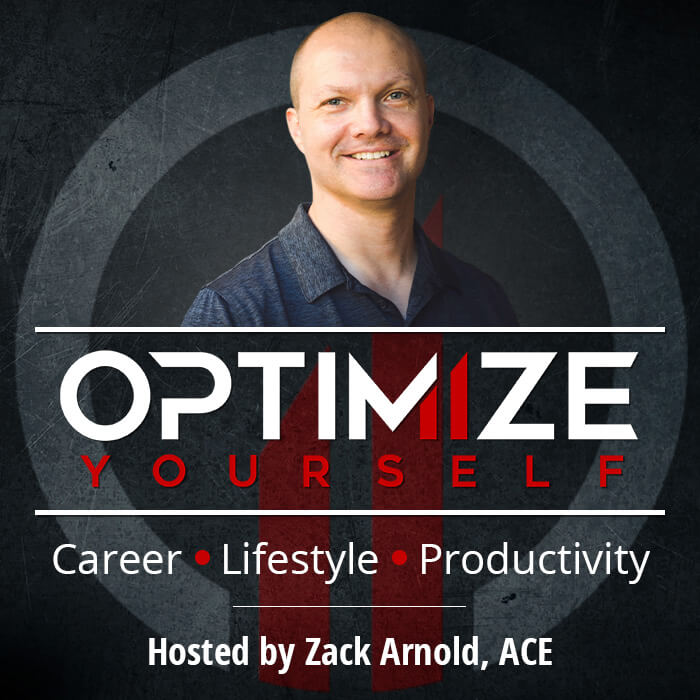

Zack Arnold
The Ultimate Guide to Building a Healthy Workstation (And Being Less Sedentary)...All For the Price of a Single Desk Chair
Author’s note: This ‘Ultimate Guide’ is a collection of over a decade of research, experimentation, and many of my past articles on the topic of living a less sedentary lifestyle. This guide is also based on many conversations with the world’s foremost experts on proper ergonomics, the dangers of being sedentary, and the benefits of more consistent movement throughout the day. There’s A LOT of information in this guide to help you build a healthy workstation and move more during your day.
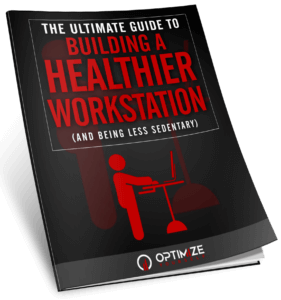 If you’d prefer to have this guide as a PDF you can reference for later use, Click here to download this ‘Ultimate Guide’ as a PDF.
If you’d prefer to have this guide as a PDF you can reference for later use, Click here to download this ‘Ultimate Guide’ as a PDF.
Working a very sedentary career as a Hollywood film & tv editor, I have spent the last two decades figuring out how to stay active all day long despite living in front of a computer (in the dark) .
Fifteen years ago when I traded in my super-fancy Herman Miller Aeron chair for a $20 exercise ball as my primary desk chair, people laughed at me.
Ten years ago when I invested $3000 in a motorized height-adjustable workstation for my home office, people thought I was crazy.
And five years ago when I moved in a desk treadmill, a doorway pull-up bar, and kettlebells to my office at Empire, people snickered thinking I had lost my mind.
Luckily a lot has changed in the last five years.
But a lot hasn’t changed as well.
While it’s true that people are becoming much more conscious about the fact that sitting is slowly killing us, they are still often seeking the wrong solutions.
The most common question I’m still asked to this day is:
“I want to invest in the best ergonomic office chair on the market for the sake of my health. What should I buy?”
This question is encouraging because it means people are (finally) recognizing that you can have a successful career because you invest in your health, not despite prioritizing your health ahead of your career.
But it’s also frustrating because it’s completely the WRONG question to ask.
If you do a search via Dr. Google for the “healthiest office chairs,” the #1 option (if budget is no object) is the Herman Miller ‘Embody’ Chair.
And it costs just under $1500.
Even more extreme, for those with ample funds to spend (who aren’t terrified of the film WALL-E becoming our reality), there is even a workstation that allows you to lie down while you work…if you’re willing to drop over $8500.

Clearly if I spent over $3k on a motorized standing desk a decade ago I have no problem investing in technology that will make my work environment healthier and more ergonomically friendly. But the last thing I would ever spend a single dollar on is a chair that is so comfortable it encourages me to sit (or lie down) for hours on end without moving.
Do not make the cardinal mistake of thinking that “ergonomic” and “healthy” are synonyms.
An “ergonomically friendly” desk chair like the Herman Miller Embody Chair will absolutely reduce lower back pain and discomfort…but unless you’re moving throughout your day, it’s still slowly killing you.
Here’s the hard truth: The probability is over 70%1 that you are sitting as you read this ultimate guide. You were probably sitting for the 60 minutes before reading this ultimate guide, and you will probably sit for the vast majority of your day after reading this ultimate guide. (Full disclaimer: I’m also sitting as I write this ultimate guide)
We sit at the breakfast table.
Then we sit in our cars (or buses…or trains) until we get to work.
Avoiding the stairs, we then take the elevator until we land at our desk chairs.
Then after between 6-12 hours of sitting at our desks, we then sit in our cars on the way back home.
Exhausted from a “crazy day” we then sit at the table while eating dinner (yeah right…more like the couch).
Then we decompress by binge-watching the latest and greatest Netflix drama until we collapse into bed (wishing we had stopped three episodes earlier).
Rinse. Lather. Repeat for 30 years.
Between sitting an average of 13 hours per day and sleeping an average of 8 hours per night (8 hours…yeah right): Americans are sedentary for an average of 21 hours per day2.
There has to be a better way, right? Right?????
Despite thinking that ‘The Perfect Chair’ will eliminate your discomfort, there’s nothing healthy about sitting in the proper ergonomic position for 12-16 hours a day.
The best ergonomic position is always your next position.
Josh Kerst, Ergonomist
The key to building a healthier workstation is combining proper ergonomics with consistent movement. Only with the right equipment AND the right habits can you truly have a “Healthy Workstation.”
The good news is you can redesign your entire work environment, your workstation, your chair, your habits, and the tools around you all for the price of a fancy office chair.
And you don’t even have to do the research…because I’ve done it for you.
What’s In This Ultimate Guide?
If you’ve decided you are ready to make a substantial investment in upgrading your work environment for the sake of your health, your creativity, and your well-being, before buying “the perfect desk chair,” here is the ultimate guide to building a healthier, more active, and more ergonomically friendly workstation…all for the price of a fancy desk chair.
This guide is working under the assumption your budget is $1500 (roughly the cost of the Herman Miller Embody Chair mentioned above). If your budget is substantially lower, I have broken this guide down to what I believe are the “Essentials,” and I have provided as many budget-friendly options as possible.
Simply mix & match the many tools from this guide to fill your most pressing needs first, then over time slowly invest in more tools as you start building in the proper daily habits to use them.
TABLE OF CONTENTS
PART I: Everything You Always Wanted to Know About Movement* (But Were Afraid to Ask)
I. Why “Sedentary Is the New Smoking” (Not Sitting)
II. Why Movement Is So Important For Your Health & Creativity
III. Why Standing (and even Exercise) Isn’t Enough
PART 2: The Gearhead’s Guide to the Best Equipment Available to Keep You Moving (And Alive)
IV. The Essential ‘Must-Haves’ For Both Sitting & Standing
V. Tools to Reduce Chronic Discomfort & Pain
VI. Tools to Increase Strength (and Burn Calories!!!)
PART 3: It’s Not Just About the Tools…It’s About Using Them Consistently
VII. How to Modify Your Daily Habits to Make Activity Effortless
Appendix: Expert Interviews & Additional Articles
AFFILIATE DISCLOSURE: I believe in 100% transparency, so please note that I receive a small commission if you purchase some of the following products below (at no additional cost to you). Your support is what helps keep this program alive. If you have any questions, please don’t hesitate to contact me.
PART I: Everything You Always Wanted to Know About Movement* (But Were Afraid to Ask)
Before diving right into all the cool tools I recommend for living a more active (and pain-free) life in front of your workstation, it would be irresponsible if I didn’t provide at least a brief overview that explains why being sedentary is so detrimental to your health, your creativity, and ultimately your lifespan.
And conversely, it’s also vital to explain on a scientific level why movement throughout your workday is so important to optimize your creativity (not to mention your physical and mental health).
And if you think you get a free pass because you already have a standing desk, or because you “hit the gym” once in a while or even regularly…keep reading.
I. Why “Sedentary Is the New Smoking” (Not Sitting)
If you have a working internet connection, you’ve most likely come across the headline ‘Sitting Is the New Smoking.’ This sensationalist phrase, as coined by Dr. James Levine, director of the Mayo Clinic at Arizona State University, is everywhere.
Yes the statistics are downright terrifying.
Chronic sitting and a lack of physical activity can lead to an increased risk of:
- Type 2 diabetes3
- Cardiovascular disease4
- Breast cancer5 and kidney disease in women6
- Colon cancer in men7
- Oh yeah….early death for people 35 yrs and older8
But like a frog slowly boiling in water, you don’t realize anything is wrong until it’s too late.
According to Dr. Levine:
Sitting is more dangerous than smoking, kills more people than HIV and is more treacherous than parachuting. We are sitting ourselves to death.
What’s most alarming to me about all of these studies as they relate to those of us who work in creative fields is they warn people of the negative and deadly consequences of sitting up to 6-8 hours per day.
Seriously? 6-8 hours?
6-8 hours is a half day for most creative professionals.
It’s not like I’m going to write, “You should be moving more throughout the day,” and you’re going to say, “Wait, what? You mean I need to be more active? Huzzah!” But knowing that sitting is bad clearly isn’t enough to motivate people. The question is given the complete and total lack of free time in the constantly-moving busyness of the 21st century, what alternative do you have?
According to the media and the multi-billion dollar fitness industry, you essentially have two options:
- Option #1: Do absolutely nothing, sit all day long, eat poorly, become fat, ugly, unattractive, and then die.
- Option #2: Exercise 6 days a week (everyone needs a “rest day” after all), eat an impeccable vegan/paleo/Mediterranean diet, and become one of those amazing “Before and After” pictures you see on late-nite infomercials.
There is a giant chasm in between these two options that I like to call “Everybody else.”
The problem is there’s nothing sexy about taking a flight of stairs instead of waiting for the elevator. You can’t make gazillions of dollars selling “moderate long-term lifestyle change.” Yet the vast majority of people fail to reach their exercise goals or complete their fitness programs because success is measured by long-term results, and results like losing 30 pounds don’t happen overnight.
Here’s the secret nobody tells you:
You don’t have to go to they gym every single day to be considered, “healthy,” but you do need to move more.
That’s the brilliance of reframing your mindset from “I have to exercise,” to “I need to move more throughout my day.”
Unlike “all or nothing” exercise programs, when you make the conscious choice to be more active, the benefits are profound and (almost) immediate.
To be clear before moving forwards, I’m not saying you shouldn’t exercise. In fact, I highly recommend it if you have a pulse. But if you are working 14 hours a day and trying to raise a family, getting to the gym or doing a round of P90X every single day just isn’t a realistic expectation.
There has to be a middle ground.
Shockingly, our genes expect us to move 10-14 miles per day9. PER DAY. If you’re already counting your steps with a Fitbit or similar technology, you know that 10,000 is the magic number recommended by the American Heart Association10. That’s roughly 5 miles per day, less than half of the movement our bodies and minds expect, according to our genetic code.
Here’s why this is terrifying if you rely on your creativity for a living – your brain functions very similar to a muscle.
With lack of activity, your brain will atrophy.
And conversely…
The more you feed your brain, the more it will grow.
The best way to feed your brain the fuel it needs to function at an optimal level (i.e. oxygen) is consistent movement.
II. Why Movement Is So Important For Your Health & Creativity
When you move, especially when you do quick bursts of high intensity exercise, even for as little as 60 seconds, your brain releases the neurotransmitters serotonin, dopamine, and norepinephrine. So every bout of activity is like taking a small dose of Prozac and Ritalin mixed together.
Exercise has been proven beyond the shadow of a doubt to help people regulate their anxiety, depression, and their attention issues11.
As someone who has suffered from adult ADD since college, I’ve been down the prescription drug road, and I took Adderall for a short time to manage my attention issues. Having also managed my depression, anxiety, and attention issues with exercise and activity, I can tell you firsthand that perpetual motion throughout the day is a much better long term solution for me.
SIDE NOTE: Just to be clear, I am not giving medical advice of any kind, especially when it comes to taking medication or choosing to eliminate medications in exchange for increased activity. So please make sure to consult your physician first before changing how you manage your own medication. I am just sharing my personal story with you to give you some personal perspective.
According to Dr. John Ratey, author of Spark: The Revolutionary New Science of Exercise and the Brain:
“A massive Dutch study of 19,288 twins and their families published in 2006 showed that exercisers are less anxious, less depressed, less neurotic, and also more socially outgoing. A Finnish study of 3,403 people in 1999 showed that those who exercise at least two to three times a week experience significantly less depression, anger, stress, and “cynical distrust” than those who exercise less or not at all.”
Beyond the release of neurotransmitters, the other very important chemical that is released during movement and exercise is called BDNF, or brain-derived neurotrophic factor. The reason this is so important is because BDNF is considered “Miracle-Gro for the brain,” meaning the more of it that is released, the faster your new neural connections can grow, the better your memory becomes, the faster you can learn new information, and thus ultimately become smarter over time.
“In a 2007 study of humans, German researchers found that people learn vocabulary words 20 percent faster following exercise than they did before exercise, and that the rate of learning correlated directly with levels of BDNF. Along with that, people with a gene variation that robs them of BDNF are more likely to have learning deficiencies. Without Miracle-Gro, the brain closes itself off to the world,” according to Ratey.
Furthermore, in my podcast interview with Dr. John Ratey, he cites a study done in Sweden with 1.2 million boys, and they found a definitive connection between fitness and cognition. Even when they tested identical twins, they found that the less active of the two had lower cognitive scores.
Beyond your creativity, perhaps your second most important professional investment (especially if you are a film editor like me) is your ability to retain information. If you have 40 hours of raw footage to review and then ultimately edit into a 42 minute episode of television, you better have systems in place to make sure you can retain as much of your raw footage as possible and synthesize your creative ideas into a finished product.
According to Dr. Joan Vernikos, the former head of the life sciences division at NASA, as well as the author of Sitting Kills, Moving Heals:
“When you are either sitting or lying down, your body is experiencing gravity in a very similar fashion as being weightless in space.”
When the force of gravity is no longer present on the human body:
- Your muscles and your bones begin to atrophy
- Blood circulation is reduced to the brain and your brain is deprived of oxygen
- Triglycerides increase (fats in the blood) and you become insulin resistant (meaning that your body goes into a pre-diabetic state)
- Inflammation in the body increases
- Your metabolism slows to burning as little as 1 calorie per minute
As depressing as this sounds, I only bring it up because if you move more throughout the day, the opposite of every single item listed above becomes true.
Movement every 20-30 minutes, even as simple as just standing up and sitting right back down, interrupts the negative effects of sitting. So it’s not really so much about the fact that you’re sitting…
“What’s important is how much time you are sitting without interruption.”
Therefore the more you are able to move throughout the day and protect your brain, the better your ability to make creative decisions, the more money you are ultimately able to earn, and the better you can provide for your family.
Time to get a standing desk and a gym membership, right?
Learn more about the effects of gravity and living a sedentary lifestyle on your health in my podcast interview with NASA Scientist Dr. Joan Vernikos.
III. Why Standing (and even Exercise) Isn’t Enough
In my podcast interview with Ben Greenfield, one of the world’s foremost health & fitness experts, we discuss in detail what is happening to your body at the physiological level when you sit for long periods during the day and why sitting can lead to all of the aforementioned health risks. But more importantly we also discuss why there is nothing inherently wrong with sitting.
Placing your body in a seated position is not doing any serious damage in and of itself, the serious damage comes when your body is chronically in the same position with little or no movement for 60-90 minutes or more at a time. The negative health consequences of being sedentary for more than 60-90 minutes apply to any position…including standing. (Click here to learn everything that science knows about standing desks)
In short, if you are standing all day:
- You are going to burn more calories.
- You will most likely increase your HDL cholesterol (aka the ‘good’ cholesterol).
- You may lose a little weight.
- You’ll probably be in a better mood.
- And even cooler, standing has an anti-aging benefit12.
And while there isn’t a ton of scientific research to back this up, I will argue that you are more creatively engaged and can maintain focus for longer periods of time. As Walter Murch said in our podcast together, being a film editor (like many other highly creative professions) is a combination of being a surgeon, an orchestra conductor, and a short order cook…all of whom stand while working.



Don’t get me wrong, a standing workstation is a great start. But don’t pat yourself on the back thinking you’ve solved all of your health problems just because you’re standing all day.
Unfortunately, standing for 12 hours in front of your workstation will only make you marginally healthier in the long run because you are still sedentary. In fact, some have even gone so far as to claim that standing desks are mostly bullshit.
What I’ve found from years of personal experience is that if you stand to avoid the chronic pain associated with sitting, you are only shifting the pain to different places in the body, especially if you don’t know how to make the transition correctly. Ask any orthopedist or chiropractor (don’t worry, you don’t have to, I already have), they’ll tell you the standing desk movement hasn’t lessened their number of regular clients, it’s just changed the problems they have.
So I guess that means finding more hours in the day to exercise, right?
Here’s where it gets really frustrating.
Even if you have miraculously found an extra hour before or after work to jog, bike, or even throw in some HIIT training, you still aren’t offsetting the negative effects of being sedentary for the vast majority of your day13. Don’t get me wrong, exercise is fantastic for you and you should be doing it, but you can’t use the excuse that it’s okay to sit for 12 hours because you exercised.
According to biomechanist Katy Bowman, author of the fantastic book Move Your DNA, you may actually be increasing your risk for cardiac issues by sitting all day and then jamming in a workout at night. By sitting all day you are restricting blood flow and circulation through your blood vessels, and when you suddenly try to pump enormous amounts of blood through these vessels very quickly, it’s like trying to run water through a kinked hose.
You may end up doing more harm than good.
To put into perspective how difficult it is to use exercise to counteract the effects of sitting and/or being sedentary, recent research has shown that it requires at least an hour of intense exercise to offset the negative effects of sitting for 6-7 hours per day14.
If you are regularly working a 12 hour shift like many creative professionals, you would need to exercise for almost 2 hours per day to reverse your risk of cancer, diabetes, heart disease, and obesity.
Do you have two hours per day to exercise on top of a 12 hour shift with no lunch break?
PART 2: The Gearhead’s Guide to the Best Equipment Available to Keep You Moving (And Alive)
IV. The Essential ‘Must-Haves’ For Both Sitting & Standing
Now that you have a clearer understanding of how being sedentary can damage your body, shorten your lifespan, and inhibit your creativity (not to mention your mental health), and now that it’s clear how beneficial moving more can be to your physical health, mental health, and optimizing your creativity, let’s dive deeper into the rabbit hole and take the first and most important steps to transforming your workstation so you can start moving more!
As a film & television editor I don’t have a “full-time” job per se, I move from one project to the next every 5-7 months. Therefore I don’t have my own permanent office to call home. Furthermore, I know many people in my industry and similar creative industries who move around far more than I do, often times changing gigs practically on a weekly basis.
Whether you have a permanent office, you move around a few times a year, or you change offices constantly, I have taken into account the varied lifestyles and work environments of creative professionals to provide what I consider the essential ‘must-have’ items I recommend every single person invest in if they want to live a more active lifestyle at the office.
In short, if I were moving to a new office (even for one day), I would go crazy if I didn’t have these essential items with me.
1. A Height-Adjustable Desk
Working at a seated desk is simply a deal-breaker for me. Not even a question. I just won’t do it. Knowing how detrimental it is to my health and creativity to be sedentary (especially if I’m also not getting any sunlight), I adamantly refuse to sit all day long. Therefore I ALWAYS work at a desk that gives me the option to both sit and stand throughout my day.
Ten years ago it wasn’t possible to request a height-adjustable workstation, and if you did, people looked at you cross-eyed because they didn’t know it was even possible to stand at a desk. For those companies and rental houses who were aware that standing desks existed, they would instead play the “budget card” and tell you they couldn’t afford to provide one. Today practically every company has access to height-adjustable workstations at an affordable price, so my first suggestion is simply to ask.
If you don’t have a permanent workstation and you move around every few months like me, request a height-adjustable workstation from the rental house equipping your office. They all have them. If you’re successful, your budget for the most important component of your healthy workstation is exactly $0.
If you work from home, or if you’ve been told it’s not possible to provide you with a height-adjustable workstation, my #1 recommendation for a budget-friendly yet high quality motorized desk is the ‘SmartDesk2’ from Autonomous.ai (starting at $348 including shipping).
— More Affordable Standing Alternatives —
If a height-adjustable desk is not a possibility either because your company won’t provide you one, they won’t allow you to bring your own, you can’t afford one, or if there simply isn’t space, below are five different options for transforming your existing sitting workstation to standing, no matter your budget (or available space).
The Varidesk is the most professional-looking, durable, and most permanent solution. But it’s also the most expensive. If you know you’ll never be provided with a height-adjustable workstation at your job, this is the best investment. If you’re looking for shorter term solutions that cost much less, see below.
Clearly these are not the best permanent solution, but as a short-term option milk crates are durable, modular, and most importantly…cheap.
If you’d prefer not to modify the top of your existing workstation and instead raise the whole surface higher, these inexpensive bed risers are the perfect solution.
- Adjustable laptop table (and paper reams)
Another good short-term solution is using an adjustable laptop table to raise up your keyboard and then using paper reams (or cardboard boxes) to raise your monitors to eye-level. Not super pretty, but still a solution. If you want to make it look more professional, throw a little black duvetyne over the boxes and you’re client-ready.
For less than $25 (and a little elbow grease) you can build platforms for your monitors and your keyboard using a few simple tools from Ikea.
Here’s the EXACT shopping list with Ikea part numbers and names (that I usually only provide to my Move Yourself program members).
The ‘Spark’ is definitely not a permanent solution (nor is it terribly pretty), but man is it useful in a pinch. It’s simply a cardboard fold-up version of a Varidesk that folds to roughly the size of a laptop case.
Below are some very creative options for converting your workstation from sitting to standing (special thanks to all of my friends who submitted these).
It doesn’t have to be pretty…it just needs to get you moving.
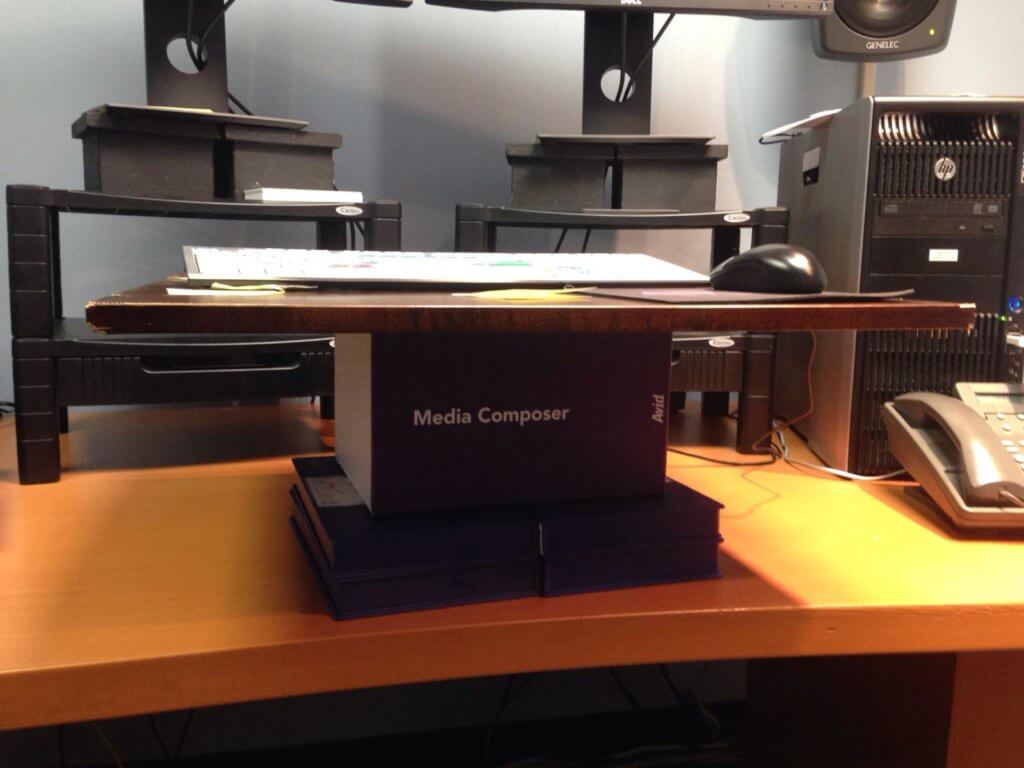



2. The ‘SitTight’ Office Chair
Despite being known as “The Standing Desk Guy,” I make it a point to change positions constantly throughout my workday, and I still sit at least 25% of the time. But when I sit, I still prefer to stay as active as possible which is why I have literally spent over a decade myself searching for ‘The perfect desk chair,’ and until recently I had to settle on a few different options (all of which I still recommend below).
Then I discovered the SitTight (use the coupon code ‘OPTIMIZE’ for 10% OFF), and my world changed overnight.
The SitTight turns sitting into an activity that can actually improve your health instead of damaging it.
Because of its unique design (think of it like a really comfortable bar stool on top of an inverted Bosu Ball), the SitTight activates the postural muscles in your spine that atrophy when you sit all day long. The activation of these muscles over time can drastically decrease the chronic aches and pains you feel in your lower back. Furthermore, constantly balancing all day increases your heart rate, improves core strength, and most importantly increases your brain activity, ultimately boosting your focus.
In short, the SitTight makes sitting at your desk a fun activity!
Perhaps the greatest feature of all about the SitTight that makes it my #1 chair recommendation is its versatility.
1) You can sit on it similar to a regular chair:

2) You can also sit on it “Saddle style” if this is more comfortable for your lower back and hips:

3) You can also remove the seat from the base if you find the balance too difficult (or you just want a break):
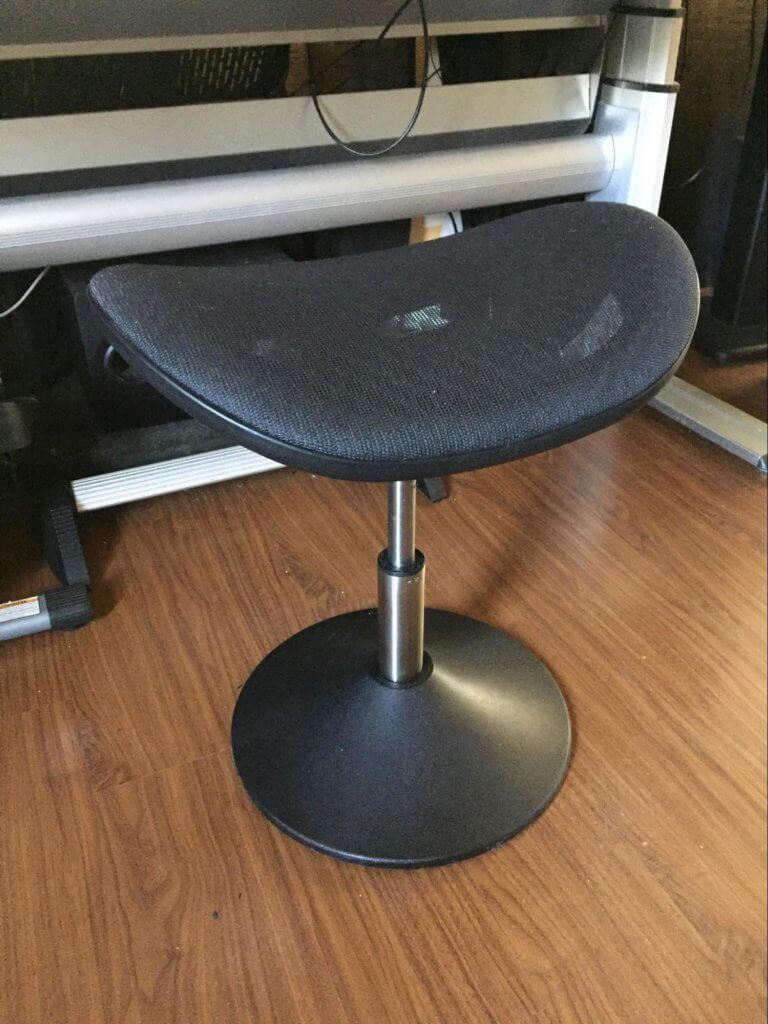
4) And the coolest combination of all is the marriage of the SitTight base with the Topo Mini (more about the Topo below). This takes your standing workstation to a new level:
Learn more about the many benefits of the SitTight in my podcast interview with SitTight creator Scott Bahneman.
— More Affordable Sitting Alternatives —
If the SitTight simply isn’t an option either for budgetary or health reasons, below I have provide my other top recommended “active sitting chairs”:
The Mogo is great for leaning or “perching” so you can remove much of the pressure from your lower back. It’s like having a portable bike seat with you. It breaks down small enough to fit in a backpack so it’s great for traveling, and it’s also very affordable. But it isn’t comfortable enough to use for longer periods throughout the day.
The Pivot is a significant upgrade from the Mogo. Like the Mogo it functions similar to having a portable bar stool that allows you to “perch” in front of your workstation and remove the pressure from your lower back, but the cool part about the Pivot is it allows you to spin, balance, and constantly move around. But it also gets uncomfortable after long periods during the day.
Until I discovered the SitTight I kept a kneeling chair by my side as a replacement for my desk chair. It’s super affordable, but more importantly it allows you to sit upright for longer periods of time because it’s so difficult to slouch while in a kneeling position. But the main drawback is the extra pressure it puts on your knees, hence why I don’t use it as often as I do my SitTight.
Curious why I don’t list an exercise ball as an option? Because sitting on an exercise ball as a desk chair is actually worse for you than a regular desk chair15. Sure, it’s “supposed to” help you engage your core muscles more, but let’s get real. After 10 minutes we just end up slouching over 5 times more than we would with a regular desk chair.
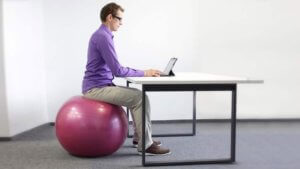

Expectation vs. Reality. You know you’re guilty of this too.
My recommendation is NOT to introduce an exercise ball as your primary desk chair…but it doesn’t hurt to have one in your office to bounce or stretch on throughout the day.
3. A Topo Mat
Hands down, the Topo Mat is the #1 product I recommend to every single person who asks me, “If you could only buy one thing for your office, what would it be?”
There’s a reason the Topo Mat is listed as #2 on my list of top ten tools.
The Topo Mat is not your boring, flat “antifatigue mat.” Those mats might make you marginally more comfortable by giving you a softer surface to stand on, but anyone who uses one regularly knows you often find yourself stuck in one position not moving…which means you’re still sedentary.
In addition to being super cushy and comfortable like most other mats, The Topo Mat is specifically designed to not be flat which encourages more movement throughout the day at your standing workstation…and the best part is you move a lot more without ever having to consciously think about it (or set reminders that you’ll eventually ignore anyway). This increased movement promotes more blood circulation, less pain in the lower body, and ultimately more focus and creativity.
If you’re standing at your desk, don’t do it without a Topo Mat. End of story.
Learn more about how the Topo encourages movement throughout the day in my podcast interview with the Topo Mat creators.
4. An Apple Box
As the companion to my Topo Mat, I never move into a new office without an apple box. If you spend the majority of your day standing instead of sitting, even with a Topo Mat encouraging more movement, you’ll still find that your lower back gets stiff, your calves get tight, and your feet get sore. Rather than spending tons of time & money chasing these symptoms with expensive massages, orthotics, or even making Advil a staple of your diet (all of which I’ve done in the past), the simplest solution is to put an apple box in front of your Topo Mat. Doing so allows you to relieve the pressure on your lower back and one leg at a time by simply shifting your weight and standing in what’s often known as “The Hero Pose.”
The apple box can also be a great exercise tool for simple stair-steppers while reviewing material or reading, and it can even serve as a makeshift backless desk chair if you’re in a pinch.
BUDGET UPDATE: Assuming you chose the most expensive options available above for both standing and sitting (i.e. the Autonomous height-adjustable workstation + the SitTight), and your original all-in chair budget was
So far we’ve barely scratched the surface.
Let’s see how deep the rabbit hole really goes…
V. Tools to Reduce Chronic Discomfort & Pain
Now that I’ve covered my essential ‘Must-Haves’ for both standing and sitting throughout the day, I want to share the many tools I’ve discovered throughout the years to help me reduce (or outright eliminate) the many forms of discomfort and pain we all experience when working in front of computers for long hours.
1. The TheraGun
Without question, the most powerful tool I’ve ever discovered to eliminate pain in my neck, shoulders, and lower back is the TheraGun.
I cannot emphasize enough that this product is simply a GAME. CHANGER.
If you’re balking at the price, take a minute to add up the chiropractor, physical therapy, and massage appointments you’ve scheduled throughout the years…then add up the additional cost to your health from living off Ibuprofen or pain killers.
The investment in this product is worth it because there’s quite possibly nothing more detrimental to your focus and creativity than chronic pain.
I originally discovered this product because I was searching for a way to reduce the pain I was experiencing from a heavy load of American Ninja Warrior training. But trust me when I say the TheraGun is not just for athletes.
This is an incredibly simple-to-use tool that can sit right on desk next to your keyboard that virtually eliminates muscle knots in minutes. Foam rollers and la crosse balls (see below) are tools I’ve recommended and used for years to reduce knots and tightness in my neck, shoulders, and lower back throughout the day. But the Theragun eliminates the knots completely. In like 60 seconds.
Seriously…I say this with zero hyperbole….the TheraGun is a miracle.
Learn more about the TheraGun in my podcast interview with TheraGun inventor Dr. Jason Wersland.
2. A TriggerPoint Foam Roller
An additional essential item I can’t live without in my office when it comes to mobility and pain relief is a TriggerPoint foam roller. Even if you invest in a TheraGun, a foam roller is a fantastic tool. But if you choose not to invest in a TheraGun, a foam roller is a must-have.
Having a foam roller by my side (it can also easily be stored under a desk or table out of sight) allows me to roll out any area of my body from head-to-toe that might be chronically tight or sore from being sedentary (or if I’m sore from athletic training). A foam roller is great for taking quick stretch breaks, and if I’m spending long periods of time reviewing footage or watching cuts, I’ll spend upwards of an hour on my roller (I do the same watching TV at night to literally “unwind” before bed).
Here’s an example from my Move Yourself Activity Video Vault of how to use a foam roller to loosen your “Glute Medius” (the outside of your hip/butt), a common area that gets tight when you sit all day long.
Here’s a bonus example for using a foam roller to loosen your shoulders, specifically the area right behind your armpit called the ‘Teres’ muscle.
Looking for a more advanced version of a foam roller? For true masochists like me, give the Rumble Roller a try.
3. Lacrosse Balls
Once you’ve hit every spot you can with a foam roller, if you’re interested in getting into smaller, harder to reach areas that a blunt object like a foam roller can’t reach, you’ll then need at least one lacrosse ball.
Think of a lacrosse ball like a masseuse’s elbow. It’s not a terribly pleasant experience, but the relief you get is absolutely astounding (if you know the right places to put the ball).
Here’s an example from my Move Yourself Activity Video Vault of how I use a lacrosse ball to the teres muscle to further reduce the discomfort in my lower back.Here’s an example from my Move Yourself Activity Video Vault of how I use a lacrosse ball to further reduce the discomfort in my lower back.
And here’s another video for those of you who experience constant discomfort and pain in the forearms (e.g. carpal tunnel syndrome).
4. Tools Specifically For Wrist & Forearm Pain
Repetitive stress injuries (RSI) and carpal tunnel are two of the most common types of pain people ask me about. When you spend all day long typing away at a keyboard, holding a pen, and/or clicking a mouse, you are putting a tremendous amount of strain on very specific muscles in your fingers, hands, wrists, and forearms.
Think of it this way: Just imagine bending a clothes hanger back and forth over and over and over until it finally breaks….that’s repetitive stress.
At one point in my career I had wrist pain so bad in my right hand (my mouse hand) that I couldn’t do a single push-up from the pain, and I was told my only option was surgery. I instead chose to do a little research and discovered a grip strength regimen had an equally high likelihood of long term success…but without surgery.
While you are drastically overusing certain muscles and tendons day after day, you are also allowing equally important muscles to atrophy because you never use them at all. Often times the solution to eliminating pain the wrists and forearms is simply strengthening all of the muscles you are underusing.
Here are the tools I keep right next to my keyboard and use every day to improve grip strength and lessen wrist & forearm pain:
Captains of Crush Grip Strengtheners
Captains of Crush Extensor Bands
Gripmaster (for individual fingers)
Variable Resistance Grip Strengthener
Needless to say at this point I’ve developed ninja-warrior-level grip strength, largely because I make it a habit to use these tools throughout my workday.
Another item I travel with to every job that I can’t go a single day without is my Anker vertical mouse.
Yes there are tons of different mouse options, Wacom and graphic tablets, trackballs, and entire gaming consoles that replace a mouse…but I’m a simpleton. I just want a device I can effortlessly hold in my hands so I can move my cursor around the screen…without causing shooting pain or numbness in my wrists and forearms. Once I made the simple transition from a regular mouse to a vertical mouse, virtually all of my discomfort and pain disappeared.
To learn more about WHY working at a keyboard causes chronic pain and repetitive stress injuries, listen to my podcast interview with Dr. Sadie Sanders.
5. Tools For Lower Body, Leg, Ankle, & Foot Pain
If you choose to stand for long periods throughout your workday (especially if you choose NOT to invest in a Topo Mat), you are going to experience lower body pain, specifically in your calves, shins, and feet. Here are a few of my favorite portable tools I keep handy for when I experience lower body & foot pain (especially plantar fasciitis which I battled for a couple years before discovering these options).
BUDGET UPDATE: With the exception of the TheraGun, every single tool I mention above costs $50 or less (most options are significantly less than
Let’s see what other options there are to spend your remaining budget wisely.
VI. Tools to Increase Strength (and Burn Calories!!!)
Now that I’ve covered my essential ‘must-have’ tools for both sitting & standing as well as all the tools I use to eliminate chronic discomfort and pain, it’s time to start getting stronger right at your desk…and even start burning some calories!
Yes…it’s possible to actually get stronger every single day and get in better shape, even if you spend your entire day stuck in front of a computer.
Here’s how.
1. Doorway Pull-Up Bar
A staple of my home office is a doorway pull-up bar with several variations of “Ninja holds” so I can continue to strengthen my grip (which as you read above helps reduce and eliminate RSI injuries and carpal tunnel). And if I’m lucky enough to work in an office space with normal doorway arches, I bring my pull-up bar to work as well.
Even if you have no interest in hanging from ridiculous obstacles, a doorway pull-up bar is an inexpensive and easy-to-install piece of equipment that anyone can use throughout the day. Don’t get overwhelmed thinking you have to do maximum reps every single day, and don’t freak out if you can’t even do a single bodyweight pull-up. Simply put a chair under the bar and make it a rule that in order to walk through your office door you have to do one pull-up (with or without the chair).
That’s it: One pull-up.
Those tiny actions add up throughout the day. And I guarantee you’ll experience a lot less brain fog in the afternoons if you’re periodically doing bodyweight pull-ups.
2. Kettlebells
Kettlebells are an absolutely staple in my office (I prefer the Onnit brand but you can get them at pretty much any store that carries exercise equipment).
Occasionally lifting heavy things helps build strength, increase circulation, and most importantly keep away the dreaded afternoon brain fog. My go-to moves are kettlebell swings, goblet squats, deadlifts, shoulder presses, and I’m working right now on perfecting my Turkish getup.
The best thing about kettlebells is they are easy to move from office to office (if you have light ones), and they’re super small so you can hide them under tables or under your desk.
3. Jump Rope
A jump rope is a fantastic tool to keep at work in a drawer or under your desk to very quickly elevate your heart rate and respiration. That quick jolt of oxygen to the brain can quickly get the creative juices flowing again, and according to multiple experts can help reduce anxiety, depression, brain fog, and over time even make you smarter.
And if you don’t have enough space for jumping with a real jump rope (or you don’t want the noise to disturb others), try a cordless jump rope instead.
4. Resistance Bands
If giant heavy chunks of iron (i.e. kettlebells) aren’t your thing, there are several different varieties of resistance bands you can roll up in a desk drawer that can still give you a very efficient workout.
This resistance band kit is one I’ve travelled with for years that allows me to do many types of exercises that I could do with a full set of dumbbells but without all the extra equipment. And the variety of colors give you a wide spectrum of resistance levels.
If you’d prefer a smaller option for more therapeutic purposes instead of simulating dumbells, I also have a set of Therabands within arm’s reach.
5. Push-Up Stands
If you’d like the option to practice handstands against the wall or take your push-up game to another level (or if regular push-ups are hard on your wrists), these Power Stands are the perfect piece of office equipment to stash under your desk.
6. Trampoline
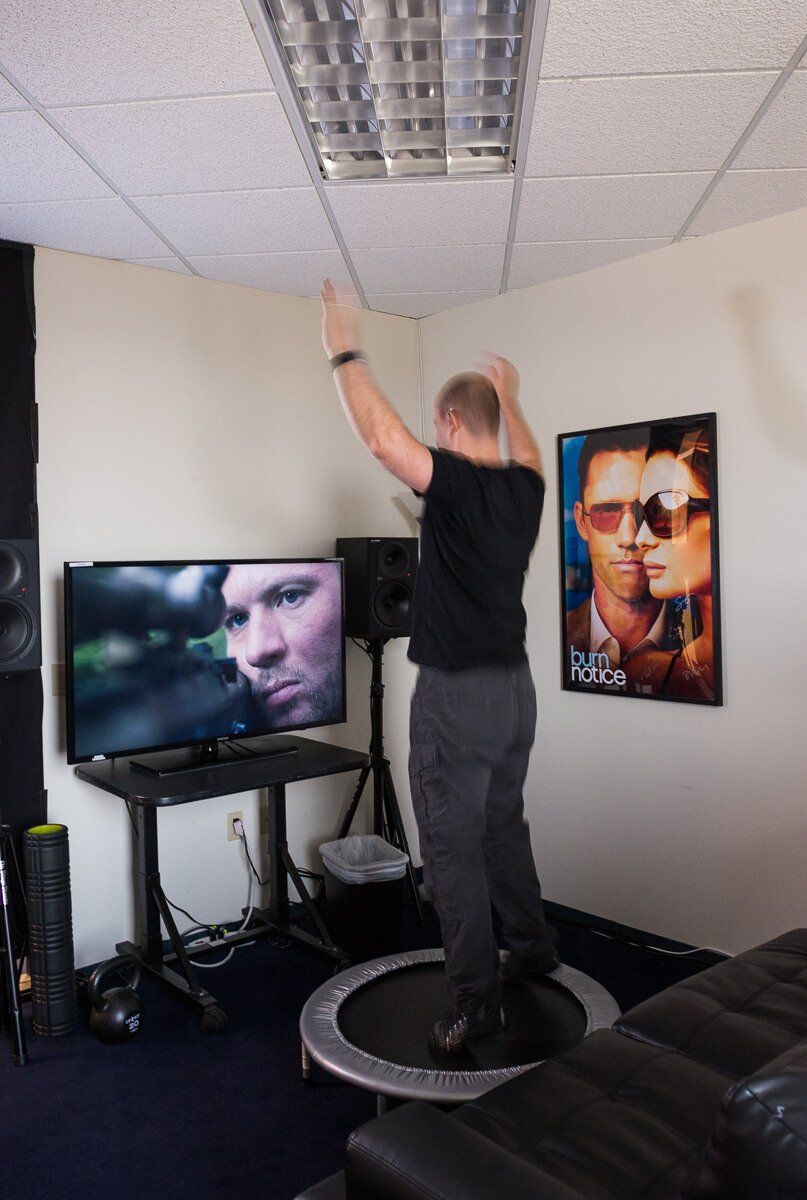
If you’re looking for a super quick way to elevate your heart rate, quickly shake up and clean out your lymphatic system, and give your creativity a boost, I highly recommend putting a trampoline somewhere in your workspace. Perhaps the best side effect of having a trampoline in your office is all the conversations it starts!
Just beware of finding random people coming into your office and using it as soon as you step out (trust me…this happens to me all the time).
BUDGET UPDATE: At this point if you’ve invested in a motorized desk from Autonomous, a SitTight, a Topo Mat/apple box combo, 4 items from section 2 (averaging at around
Below I have provided bonus options for taking daily activity to the next level, but with the caveat these are an additional investment that exceeds your original $1500 budget of buying “the perfect chair.”
7. Under Desk Treadmill
For several years while working on the shows Black Box and Empire I worked with a treadmill desk all day long, my favorite brand being the Lifespan Under Desk Treadmill. While it seems difficult to type and walk at the same time, I got the hang of it in mere minutes, and everyone that gave it a try was able to pick it up in less than five minutes as well.
Having an under desk treadmill is a great way to burn calories continuously throughout the day and keep your metabolism elevated, as well as your heart rate. If you have trouble “getting in your steps” every day but really want to earn that 10k badge in the Fitbit app, a treadmill desk is your next best option.
Note: The reason I no longer have a treadmill desk is not because they don’t work, it’s because I wanted to continue experimenting with multiple pieces of sitting & standing equipment…and it’s simply too difficult to move a treadmill back and forth all day long when you have five other pieces of equipment around you.
8. Under Desk Bicycle
If you’re not a treadmill person, there is also the Lifespan Under Desk Bicycle which like the treadmill offers the option to move continuously throughout the day and burn far more calories than you would if sedentary. I’m not a big bicycle person so I haven’t tried one of these myself, but for those who enjoy bicycles I know this is a great option.
9. Under Desk Elliptical Trainer
A third and equally good option for burning calories consistently at your desk is the In-Motion Elliptical Trainer. What I love about this option (besides the insanely reasonable price) is that it’s super small but packs a big punch. You can literally hide this right under your desk and nobody would ever notice. I often use the elliptical while either reading scripts, watching raw footage, or while writing.
PART 3: It’s Not Just About the Tools…It’s About Using Them Consistently
VII. How to Modify Your Daily Habits to Make Activity Effortless
If you’ve stuck with me so far, you’ve exhausted (and perhaps even exceeded) your original “healthy chair” budget of $1500. But which would you rather have…ONE fancy office chair that reduces fatigue and discomfort…or TEN different pieces of equipment that keep you more active, make you stronger, more focused, creative, and all but eliminate your fatigue and discomfort?
That’s what I thought.
Now that you’ve surrounded yourself with the proper tools and educated yourself a bit about the benefits of moving more, it’s time to modify your behaviors throughout your workday to avoid being sedentary as much as possible…without requiring any additional time in your day.
Here’s the great news about this section:
Modifying your habits and behaviors is 100% FREE
On a normal day I spend a minimum of 12 hours in front of a computer, on a busy day upwards of 16. Maybe it was 4 years of living & breathing Michael Westen while editing Burn Notice that inspired me to figure out a way to hack my surroundings and behaviors like a super spy, or perhaps it’s just sheer survival instincts given that I’m raising two small kids and trying to make a living in Los Angeles in one of the most competitive industries on the planet.
No matter the initial inspiration, without much effort I’m now able to get between 10,000 and 15,000 steps on a normal workday.
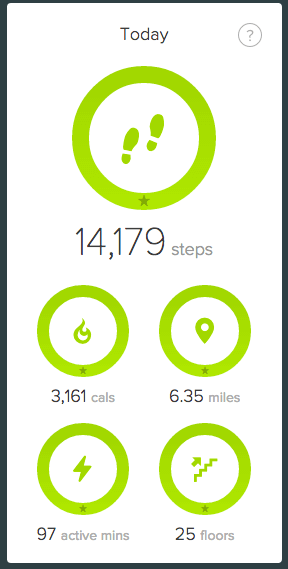
This is an example of a fairly normal day of activity for me while working (I generally average about 10k steps…so this was a good day).
If you’re interested in building healthy habits to pair with all the new office equipment you’ve invested in to be more active, here are seven different options for modifying habits you’re already doing every day so you can be more active (without even thinking about it).
1. Introduce NEAT Movement Into Your Day
NEAT is a term coined by James Levine, an exercise physiologist at the Mayo Clinic, and it stands for Non-Exercise Activity Thermogenesis. Defined in the simplest terms, NEAT movements are the small, brief, and frequent muscle movements one makes throughout the day. These frequent movements to incorporate into your daily routine can be as simple as:
- Standing up
- Sitting back down
- Bending over to pick something up
- Crossing your legs
- Shifting positions often
- Stretching periodically
Think of yourself as the tortoise, not the hare. Sprinting quickly (i.e. exercising vigorously) and then sitting all day long isn’t as beneficial for you as slowly moving constantly throughout the day.
In my podcast interview with Ergonomist Josh Kerst, he mentions the “10 and 2” rule, meaning every 10 minutes or so initiate a change in posture for 2 minutes, ideally standing as well (if you’re not already). In addition to having physical benefits, integrating more NEAT activity into your day will have a positive effect on your attention, focus, cognitive function, and creativity as well.
Added time to your day: Approximately 0 minutes.
2. Organize Your Work Environment to Be LESS Efficient
Given that I live and breath productivity, it may seem counterintuitive that I’m recommending you rearrange your office environment so it becomes less efficient, but there is nothing less efficient than being sedentary all day long.
Movement is the secret to consistent levels of focus and productivity throughout the day.
Forget feng shui…while you may be thinking you are saving time by having all of your essential tools within arm’s reach (e.g. your printer, stapler, file folders, trash can, etc), the lack of activity you get throughout the day by never moving actually makes you infinitely less productive.
Simply assess your office layout and start rearranging frequently used items so they are out of reach. For example, my trash can is never under my desk within arm’s reach, it’s always in the exact opposite corner of the room. That way I’m forced to take 15-20 steps to throw something away (unless I want to shoot some “office hoops”). Now apply the same principle to frequently used items such as printers, pens, pencils, staplers, or bookshelves with binders. Make everything as inefficient as possible so you are forced to change positions to grab items throughout your day. This will introduce a significant amount of NEAT movement into your routine (for more on NEAT movement, scroll above to option #1).
This one step alone could yield standing up 30-40 more times per day without you ever having to think about it.
Added time to your day: Approximately 1-5 minutes.
3. Make Water Your Secret Weapon (And Turn Bathroom Breaks Into “Smoke Breaks”)
The idea here is to use water as your ultimate weapon against being sedentary.
There are two components to this strategy:
- Drink water like it’s going out of style
- Place your water just out of arm’s reach so you are forced to stand when you drink (an additional form of NEAT movement)
By placing your water out of arm’s reach you are forced to stand every time you take a drink, and secondly if you drink like a fish you’ll have to pee like a racehorse.
On that note…it’s been acceptable for decades to step outside several times a day and voluntarily commit suicide in the company’s back alley, now it’s time to take the same liberty with your bathroom breaks. But now instead of shortening your lifespan, you’ll be extending it!
Since you’re now drinking copious amounts of water you’ll be taking bathroom breaks every couple of hours (probably more). Instead of running to the bathroom and returning as quickly as possible, use this time to focus on activity.
- Take the furthest path possible to reach the bathroom
- Find your secret place to do quick activity breaks
When I was editing Empire I worked on the 4rd floor, but I would often walk down the steps to the main lobby to use the bathroom. I would then walk back up the steps, but before returning to work I would do 2-5 minutes of high intensity exercises in the stairwell. Those 2-5 minutes often bought me an additional 2-3 hours of high energy, focused creative work.
Added time to your day: Approximately 1-5 minutes.
4. Park As Far Away As Possible (And then Ditch the Elevator and Take the Stairs Instead)
Here is a parking lot outside one of the studios I’ve worked at in the past.
Here’s where I could have parked:

Here’s where I chose to park instead:

Depending on how far away your parking space is from the office, you can add upwards of 1000+ steps just by making the conscious choice to park further away. And as an added bonus, your mornings will be LESS stressful because you no longer have to fight for the best space. The ‘best space’ for you will now be in the back corner on the roof of the parking structure…and there’s no need to fight for that one!
Once you’ve chosen your optimal stop as far away as possible, choose to take the stairs to your office instead of the elevator.
(If) Your legs work…Use them.
Added time to your day: Approximately 5-10 minutes.
5. Make It a Rule to Walk If You’re On the Phone
If I could choose only one strategy from this section that yields the most bang for your buck it would be this one. By simply making the conscious choice to take walks whenever you are on the phone, you could add upwards of 5-10k steps per day!
For example, if I’m on a notes call or a conference call, I will choose a safe walking path where I don’t have to focus on traffic or my safety…all I have to do is walk around the block over and over and over. This helps me stay focused on the call, it gives me more energy which translates as being more passionate and attentive on the phone, and without thinking about it, at the end a 60 minute call I’ll be 7500 steps richer.
If you get an impromptu phone call you weren’t expecting that will only last a few minutes, walk in circles in your office.
Added time to your day: Approximately 0 minutes. (you’d be on the phone anyway)
6. Talk to Colleagues In Person (Ditch IM, Texts, and Office Phones)
I have simply made it a rule that I don’t use the phone for communicating at the office. If I can walk to someone’s office, I don’t use the phone. Ever. I set the tone on my first day of a new job and let my colleagues know if they want to communicate with me they can send an e-mail, an instant message, or knock on my door.
To be clear, I don’t tell everyone I’m working with they MUST communicate with me in person, but my general rule is that if I want to communicate with someone else, I make the effort to seek them out in person. When it comes to super simple requests that can be answered in a single sentence, I’m not going to interrupt my colleague’s or assistant’s creative flow by knocking on their door, I will just send a quick Slack message. But in general if the answer I’m requesting requires more than a simple answer, and moreover if communicating for 3 minutes in person avoids an email or IM chain with 20 different responses, I always make it a point to reach out in person.
Trust me. If you want to build deeper meaningful relationships with your colleagues, try connecting like a real human being. The side effect is getting more steps into your day!
Added time to your day: Approximately 1-5 minutes.
7. Take A Minimum of One Walking Break Per Day
I have made it a regular habit to take a 15-30 minute walk shortly after I wake up in the morning to get some sun and wake myself up. This helps reset your circadian rhythm (which pays off by helping you wind down at the end of the day and sleep better). Then in the afternoons when I feel my energy slumping and my creative juices hitting a wall, I’ll also habitually take a walk around 4pm every afternoon (when I’m not in the room with a client).
As mentioned in Section 1, movement activates the thinking brain, and there’s no better way to clear your head and solve creative problems than taking a walk. In fact according to research done at Stanford, simply walking versus sitting can boost creativity by upwards of 60%16.
The next time you feel guilty (or downright afraid) of taking a walking break, keep in mind that you’re still working.
Which do you think is more efficient, trying to solve a problem by endlessly staring at a screen while sitting on your ass, or forcing yourself into a different environment and moving around so your brain can breath?
Think of it this way…where have you had more brilliant epiphanies in your life…in front of a computer, or in the shower?
Yup. That’s what I thought.
Added time to your day: Approximately 15-30 minutes.
To Sit Or Not To Sit…That Is the Question
Phew! That’s A LOT of information. Bet you didn’t know you had so many options available to you for being more active in an otherwise sedentary work environment, did you? That’s okay, I had no idea any of this stuff existed until I started obsessively researching and experimenting with everything I could get my hands on.
Today, without even thinking about it, I average 10k+ steps per day (not including exercise or ninja training), I’m constantly taking breaks but still meeting my deadlines, I’m able to maintain my focus for longer periods (which gets me home to my kids sooner), and I just feel better.
If you’re interested in taking “the red pill” and seeing just how deep this rabbit hole really goes, I invite you to join my ‘Move Yourself’ program to bring together all of the knowledge and expertise I’ve shared with you in this ultimate guide (plus a ton more) into a simple and repeatable daily system that will lead to:
- More consistent energy throughout your (long) day
- A heightened ability to enter a state of “creative flow”
- Increasing your metabolism
- Burning more calories
- Having less brain fog
- More bursts of creativity
- Arriving home at night to your family with energy to spare
I look forward to seeing you inside!
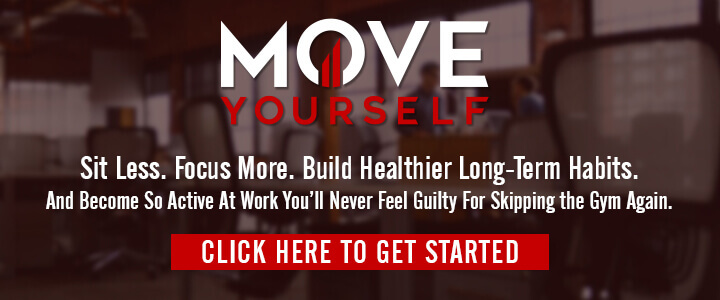
Appendix: Expert Interviews & Additional Articles
Note that much of what you’ve read above is already contained in many of my past articles and podcasts, but if you’d like to go deeper on any specific topic, below is an appendix of every resource available on this site to get you moving.
Podcast Interviews:
Ep52: Taking Recovery to a Whole New Level with the TheraGun | with Dr. Jason Wersland
Ep51: Don’t Just Sit…SitTight | with Scott Bahneman
Ep30: How Regular Movement Makes You Smarter | with Dr. John Ratey
Ep23: How Being Sedentary Is Damaging You (According to NASA) | with Dr. Joan Vernikos
Ep02: Deskbound – Standing Up To a Sitting World | with Dr. Kelly Starrett
BONUS: Take Your Standing Workstation to the Next Level with the ‘Topo Mat’
Articles:
The Beginner’s Guide to Alleviating Chronic Pain In 5 Min a Day…Right at Your Desk [VIDEOS]
The Magic of Postural Modification (And How It Can Cure Your Back Pain Better Than a Doctor)
The Freelancer’s Guide to Building a “Dynamic Workstation On the Go”
Tired of Sitting and Want to Ignite Your Energy & Creativity? Start Moving More.
Ready to Blow Your Paycheck On ‘The Perfect Chair?’ Read This First.
Sitting Is Killing You, But Standing Isn’t the Answer (And Neither is Exercise)
Transform Your Edit Suite Into a Gym
SOURCES:
2 Our Modern Sedentary Lifestyle – JustStand.Org
3, 4 Sitting Too Much May Lead to Diabetes, Heart Disease – WebMD
5 Sitting Too Much Increases Cancer Risk in Women – Cancer.org
6,7 Prolonged Sitting Linked to Kidney Disease – WebMD
9 Deskbound: Standing Up to a Sitting World – Amazon.com
10 The Magic of 10,000 Steps – Fitbit.com
11 Spark: The Revolutionary New Science of Exercise and the Brain – Amazon.com
12 Everything Science Knows Right Now About Standing Desks – FastCompany.com
13 Even for the active, a long sit shortens life and erodes health – LATimes.com
14 Does Sitting Really “Cancel” the Benefits of Exercise? – RunnersWorld.com
15 Is Sitting On An Exercise Ball At Work A Bad Idea? – BuiltLean.com
16 Stanford study finds walking improves creativity – Standford.edu

